

Eight Disciplines of Problem Solving (8D)
– Eight Disciplines of Problem Solving –
⇓ Introduction to 8D
⇓ What is 8D
⇓ Why Apply 8D
⇓ When to Apply 8D
⇓ How to Apply 8D

Introduction to Eight Disciplines of Problem Solving (8D)
The Eight Disciplines of Problem Solving (8D) is a problem solving methodology designed to find the root cause of a problem, devise a short-term fix and implement a long-term solution to prevent recurring problems. When it’s clear that your product is defective or isn’t satisfying your customers, an 8D is an excellent first step to improving Quality and Reliability.
Ford Motor Company developed this problem solving methodology, then known as Team Oriented Problem Solving (TOPS), in the 1980s. The early usage of 8D proved so effective that it was adopted by Ford as the primary method of documenting problem solving efforts, and the company continues to use 8D today.
8D has become very popular among manufacturers because it is effective and reasonably easy to teach. Below you’ll find the benefits of an 8D, when it is appropriate to perform and how it is performed.
What is Eight Disciplines of Problem Solving (8D)
The 8D problem solving process is a detailed, team oriented approach to solving critical problems in the production process. The goals of this method are to find the root cause of a problem, develop containment actions to protect customers and take corrective action to prevent similar problems in the future.
The strength of the 8D process lies in its structure, discipline and methodology. 8D uses a composite methodology, utilizing best practices from various existing approaches. It is a problem solving method that drives systemic change, improving an entire process in order to avoid not only the problem at hand but also other issues that may stem from a systemic failure.
8D has grown to be one of the most popular problem solving methodologies used for Manufacturing, Assembly and Services around the globe. Read on to learn about the reasons why the Eight Disciplines of Problem Solving may be a good fit for your company.
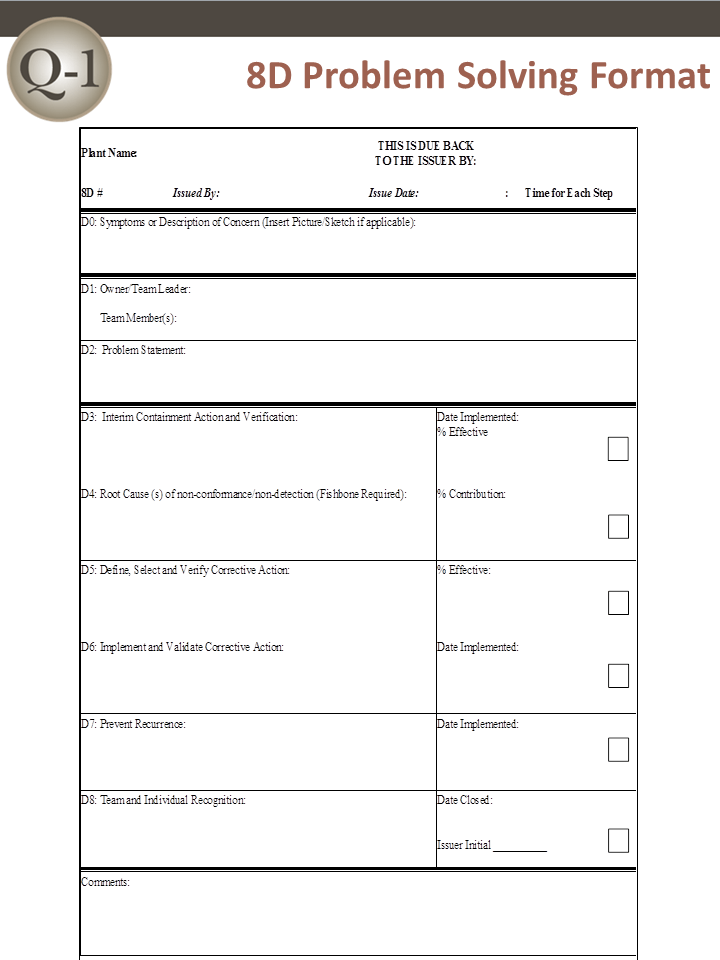
Why Apply Eight Disciplines of Problem Solving (8D)
The 8D methodology is so popular in part because it offers your engineering team a consistent, easy-to-learn and thorough approach to solving whatever problems might arise at various stages in your production process. When properly applied, you can expect the following benefits:
- Improved team oriented problem solving skills rather than reliance on the individual
- Increased familiarity with a structure for problem solving
- Creation and expansion of a database of past failures and lessons learned to prevent problems in the future
- Better understanding of how to use basic statistical tools required for problem solving
- Improved effectiveness and efficiency at problem solving
- A practical understanding of Root Cause Analysis (RCA)
- Problem solving effort may be adopted into the processes and methods of the organization
- Improved skills for implementing corrective action
- Better ability to identify necessary systemic changes and subsequent inputs for change
- More candid and open communication in problem solving discussion, increasing effectiveness
- An improvement in management’s understanding of problems and problem resolution
8D was created to represent the best practices in problem solving. When performed correctly, this methodology not only improves the Quality and Reliability of your products but also prepares your engineering team for future problems.
When to Apply Eight Disciplines of Problem Solving (8D)
The 8D problem solving process is typically required when:
- Safety or Regulatory issues has been discovered
- Customer complaints are received
- Warranty Concerns have indicated greater-than-expected failure rates
- Internal rejects, waste, scrap, poor performance or test failures are present at unacceptable levels
How to Apply Eight Disciplines of Problem Solving (8D)
The 8D process alternates inductive and deductive problem solving tools to relentlessly move forward toward a solution. The Quality-One approach uses a core team of three individuals for inductive activities with data driven tools and then a larger Subject Matter Expert (SME) group for the deductive activities through brainstorming, data-gathering and experimentation.
D0: Prepare and Plan for the 8D
Proper planning will always translate to a better start. Thus, before 8D analysis begins, it is always a good idea to ask an expert first for their impressions. After receiving feedback, the following criterion should be applied prior to forming a team:
Collect information on the symptoms
Use a Symptoms Checklist to ask the correct questions
Identify the need for an Emergency Response Action (ERA), which protects the customer from further exposure to the undesired symptoms
D1: Form a Team
A Cross Functional Team (CFT) is made up of members from many disciplines. Quality-One takes this principle one step further by having two levels of CFT:
- The Core Team Structure should involve three people on the respective subjects: product, process and data
- Additional Subject Matter Experts are brought in at various times to assist with brainstorming, data collection and analysis
Teams require proper preparation. Setting the ground rules is paramount. Implementation of disciplines like checklists, forms and techniques will ensure steady progress. 8D must always have two key members: a Leader and a Champion / Sponsor:
- The Leader is the person who knows the 8D process and can lead the team through it (although not always the most knowledgeable about the problem being studied)
- The Champion or Sponsor is the one person who can affect change by agreeing with the findings and can provide final approval on such changes
D2: Describe the Problem
The 8D method’s initial focus is to properly describe the problem utilizing the known data and placing it into specific categories for future comparisons. The “Is” data supports the facts whereas the “Is Not” data does not. As the “Is Not” data is collected, many possible reasons for failure are able to be eliminated. This approach utilizes the following tools:
- Problem Statement
- Affinity Diagram (Deductive tool)
- Fishbone/Ishikawa Diagram (Deductive tool)
- Problem Description
D3: Interim Containment Action
In the interim, before the permanent corrective action has been determined, an action to protect the customer can be taken. The Interim Containment Action (ICA) is temporary and is typically removed after the Permanent Correct Action (PCA) is taken.
- Verification of effectiveness of the ICA is always recommended to prevent any additional customer dissatisfaction calls
D4: Root Cause Analysis (RCA) and Escape Point
The root cause must be identified to take permanent action to eliminate it. The root cause definition requires that it can be turned on or off, at will. Activities in D4 include:
- Comparative Analysis listing differences and changes between “Is” and “Is Not”
- Development of Root Cause Theories based on remaining items
- Verification of the Root Cause through data collection
- Review Process Flow Diagram for location of the root cause
- Determine Escape Point, which is the closest point in the process where the root cause could have been found but was not
D5: Permanent Corrective Action (PCA)
The PCA is directed toward the root cause and removes / changes the conditions of the product or process that was responsible for the problem. Activities in D5 include:
- Establish the Acceptance Criteria which include Mandatory Requirements and Wants
- Perform a Risk Assessment / Failure Mode and Effects Analysis (FMEA) on the PCA choices
- Based on risk assessment, make a balanced choice for PCA
- Select control-point improvement for the Escape Point
- Verification of Effectiveness for both the PCA and the Escape Point are required
D6: Implement and Validate the Permanent Corrective Action
To successfully implement a permanent change, proper planning is essential. A project plan should encompass: communication, steps to complete, measurement of success and lessons learned. Activities in D6 include:
- Develop Project Plan for Implementation
- Communicate the plan to all stakeholders
- Validation of improvements using measurement
D7: Prevent Recurrence
D7 affords the opportunity to preserve and share the knowledge, preventing problems on similar products, processes, locations or families. Updating documents and procedures / work instructions are expected at this step to improve future use. Activities in D7 include:
- Review Similar Products and Processes for problem prevention
- Develop / Update Procedures and Work Instructions for Systems Prevention
- Capture Standard Work / Practice and reuse
- Assure FMEA updates have been completed
- Assure Control Plans have been updated
D8: Closure and Team Celebration
Teams require feedback to allow for satisfactory closure. Recognizing both team and individual efforts and allowing the team to see the previous and new state solidifies the value of the 8D process. Activities in D8 include:
- Archive the 8D Documents for future reference
- Document Lessons Learned on how to make problem solving better
- Before and After Comparison of issue
- Celebrate Successful Completion
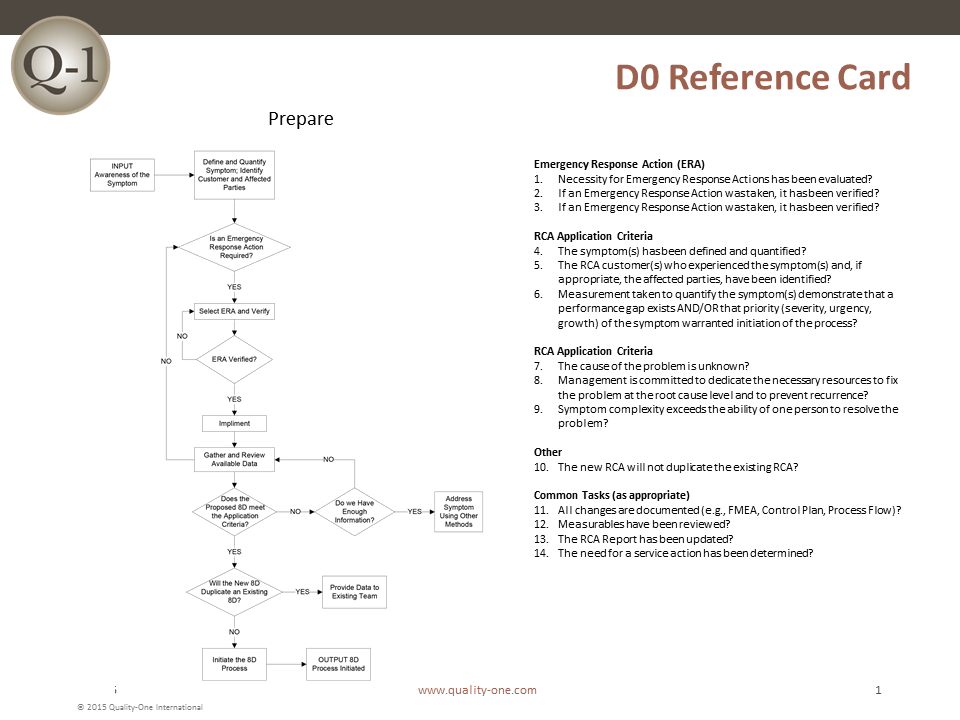
8D and Root Cause Analysis (RCA)
The 8D process has Root Cause Analysis (RCA) imbedded within it. All problem solving techniques include RCA within their structure. The steps and techniques within 8D which correspond to Root Cause Analysis are as follows:
- Problem Symptom is quantified and converted to “Object and Defect”
- Problem Symptom is converted to Problem Statement using Repeated Whys
- Possible and Potential Causes are collected using deductive tools (i.e. Fishbone or Affinity Diagram)
- Problem Statement is converted into Problem Description using Is / Is Not
- Problem Description reduces the number of items on the deductive tool (from step 3)
- Comparative Analysis between the Is and Is Not items (note changes and time)
- Root Cause theories are developed from remaining possible causes on deductive tool and coupled with changes from Is / Is Not
- Compare theories with current data and develop experiments for Root Cause Verification
- Test and confirm the Root Causes
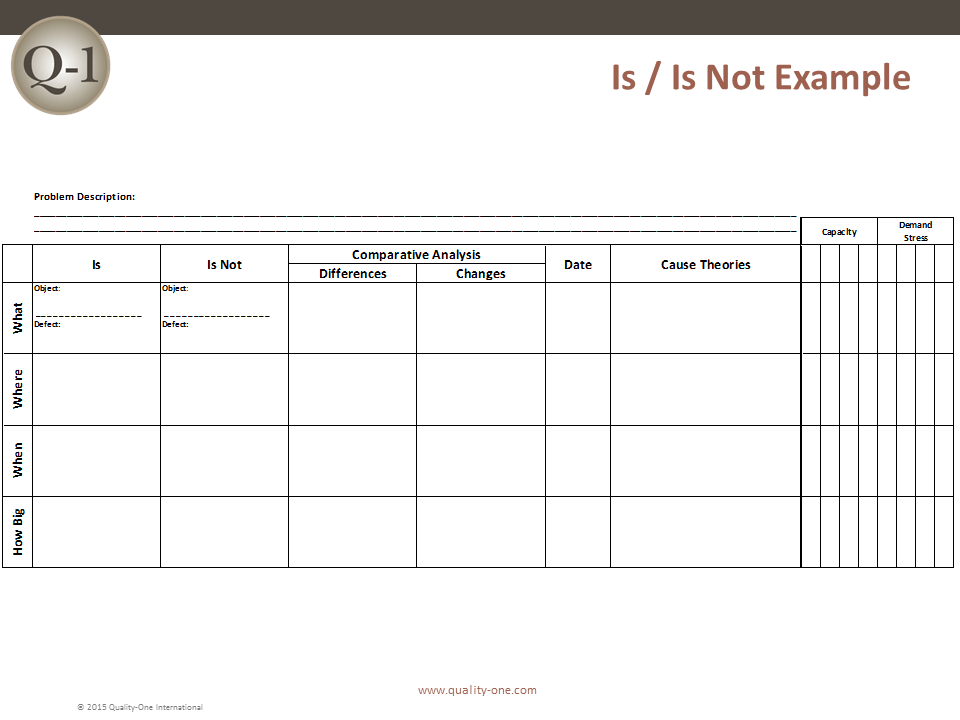
Example: Multiple Why Technique
The Multiple / Repeated Why (Similar to 5 Why) is an inductive tool, which means facts are required to proceed to a more detailed level. The steps required to determine problem statement are:
- Problem Symptom is defined as an Object and Defect i.e. “Passenger Injury”
- Why? In every case “SUV’s Roll Over”
- Why? In every case, it was preceded by a “Blown Tire”
- Why? Many explanations may be applied, therefore the team cannot continue with another repeated why past “Blown Tire”
- Therefore, the Problem Statement is “Blown Tire”
- Why? Low (Air) Pressure, Tire Defect (Degradation of an Interface) and High (Ambient) Temperature
- Counter measures assigned to low pressure and tire defect
This example uses only 4 of the 5 Whys to determine the root causes without going further into the systemic reasons that supported the failure. The Repeated Why is one way to depict this failure chain. Fault Tree Analysis (FTA) could also be used.
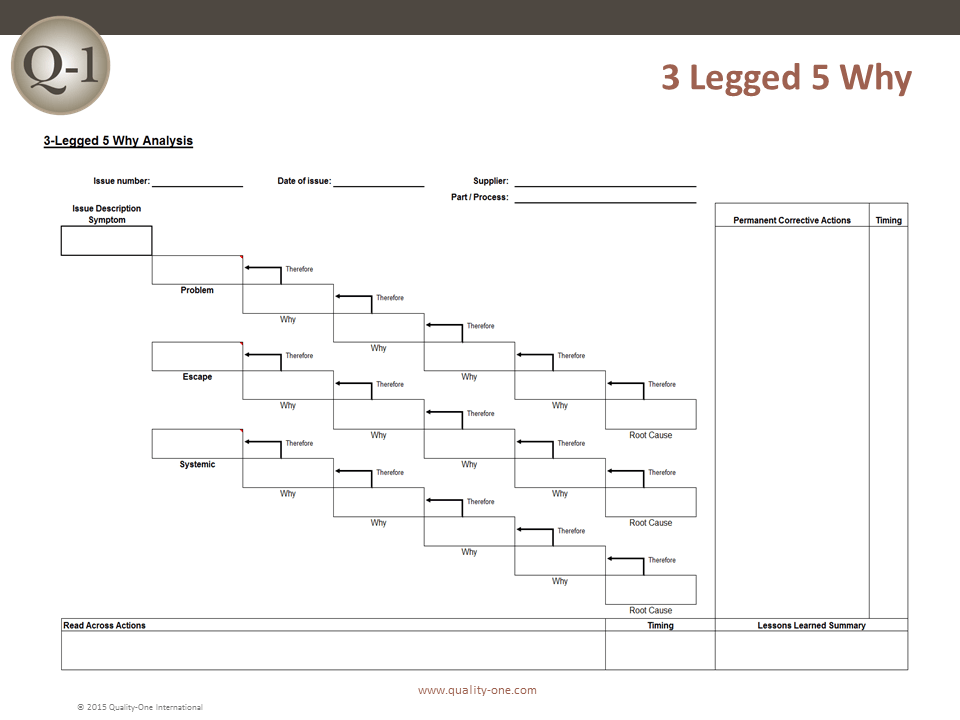
Learn More About Eight Disciplines of Problem Solving (8D)
Quality-One offers Quality and Reliability Support for Product and Process Development through Consulting, Training and Project Support. Quality-One provides Knowledge, Guidance and Direction in Quality and Reliability activities, tailored to your unique wants, needs and desires. Let us help you Discover the Value of 8D Consulting , 8D Training or 8D Project Support .
Contact Us | Discover the Value!
(248) 280-4800 | [email protected]
Remember Me
- Don't have an account? Register
- Lost your password? Click here
- Already have an account? Log in

- Product overview
- All features
- App integrations
CAPABILITIES
- project icon Project management
- Project views
- Custom fields
- Status updates
- goal icon Goals and reporting
- Reporting dashboards
- workflow icon Workflows and automation
- portfolio icon Resource management
- Capacity planning
- Time tracking
- my-task icon Admin and security
- Admin console
- asana-intelligence icon Asana AI
- list icon Personal
- premium icon Starter
- briefcase icon Advanced
- Goal management
- Organizational planning
- Campaign management
- Creative production
- Content calendars
- Marketing strategic planning
- Resource planning
- Project intake
- Product launches
- Employee onboarding
- View all uses arrow-right icon
- Project plans
- Team goals & objectives
- Team continuity
- Meeting agenda
- View all templates arrow-right icon
- Work management resources Discover best practices, watch webinars, get insights
- What's new Learn about the latest and greatest from Asana
- Customer stories See how the world's best organizations drive work innovation with Asana
- Help Center Get lots of tips, tricks, and advice to get the most from Asana
- Asana Academy Sign up for interactive courses and webinars to learn Asana
- Developers Learn more about building apps on the Asana platform
- Community programs Connect with and learn from Asana customers around the world
- Events Find out about upcoming events near you
- Partners Learn more about our partner programs
- Support Need help? Contact the Asana support team
- Asana for nonprofits Get more information on our nonprofit discount program, and apply.
Featured Reads

- Project management |
- What is 8D? A template for efficient pr ...
What is 8D? A template for efficient problem-solving
How you respond when problems arise is one of the most defining qualities of a manager. Luckily, there are tools you can use to master problem-solving. The 8D method of problem-solving combines teamwork and basic statistics to help you reach a logical solution and prevent new issues from arising.
You’ve spent months overseeing the development of your company's newest project. From initiation, planning, and execution, you’re confident this may be your best work yet.
Until the feedback starts rolling in.
There’s no sugar-coating it—things don’t always go as planned. But production or process issues are hardly a signal to throw in the towel. Instead, focus on honing your problem-solving skills to find a solution that keeps it from happening again.
The 8D method of problem solving emphasizes the importance of teamwork to not only solve your process woes but prevent new ones from occurring. In this guide, we’ll break down what 8D is, how to use this methodology, and the benefits it can give to you and your team. Plus, get an 8D template to make solving your issue easier.
What is 8D?
The eight disciplines (8D) method is a problem-solving approach that identifies, corrects, and eliminates recurring problems. By determining the root causes of a problem, managers can use this method to establish a permanent corrective action and prevent recurring issues.
How do you use the 8D method?
The 8D method is a proven strategy for avoiding long-term damage from recurring problems. If you’re noticing issues in your workflow or processes, then it’s a good time to give this problem-solving method a try.
To complete an 8D analysis, follow “the eight disciplines” to construct a statistical analysis of the problem and determine the best solution.
The eight disciplines of problem-solving
8D stands for the eight disciplines you will use to establish an 8D report. As you may notice, this outline starts with zero, which makes nine total disciplines. The “zero stage” was developed later as an initial planning stage.
To illustrate these steps, imagine your organization experienced a decline in team innovation and productivity this past year. Your stakeholders have noticed and want to see changes implemented within the next six months. Below, we’ll use the 8D process to uncover a morale-boosting solution.
![8d method of problem solving [inline illustration] D8 problem solving approach (infographic)](https://assets.asana.biz/transform/6ab7c188-3258-4d2e-afe6-9a4a084cc09f/inline-productivity-8d-template-1-2x?io=transform:fill,width:2560&format=webp)
D0: Prepare and plan
Before starting the problem-solving process, evaluate the problem you want to solve. Understanding the background of the problem will help you identify the root cause in later steps.
Collect information about how the problem has affected a process or product and what the most severe consequences may be. Planning can include:
Gathering data
Determining the prerequisites for solving the problem
Collecting feedback from others involved
![8d method of problem solving [inline illustration] D0 Planning (example)](https://assets.asana.biz/transform/abc3621d-e1ae-47ff-b731-0ee38cff99e9/inline-productivity-8d-template-2-2x?io=transform:fill,width:2560&format=webp)
If we look back at our example, you may want to figure out whether this decline in morale is organization-wide or only applies to a few departments. Consider interviewing a few employees from different departments and levels of management to gain some perspective. Next, determine what knowledge and skills you will need to solve this lapse in productivity.
D1: Form your team
Create a cross-functional team made up of people who have knowledge of the various products and workflows involved. These team members should have the skills needed to solve the problem and put corrective actions in place.
Steps in this discipline may include:
Appointing a team leader
Developing and implementing team guidelines
Determining team goals and priorities
Assigning individual roles
Arranging team-building activities
![8d method of problem solving [inline illustration] D1 Team members (example)](https://assets.asana.biz/transform/51986017-5150-4dd4-940c-252cd0eb8ba5/inline-productivity-8d-template-3-2x?io=transform:fill,width:2560&format=webp)
From our example, a solid team would consist of people with first-hand experience with the issues—like representatives from all departments and key people close to workshop-level work. You may also want to pull someone in from your HR department to help design and implement a solution. Most importantly, make sure the people you choose want to be involved and contribute to the solution.
D2: Identify the problem
You may have a good understanding of your problem by now, but this phase aims to break it down into clear and quantifiable terms by identifying the five W’s a and two H’s (5W2H):
Who first reported the problem?
What is the problem about?
When did it occur and how often?
Where did it occur (relating to the sector, supplier, machine, or production line involved)?
Why is solving the problem important?
How was the problem first detected?
How many parts/units/customers are affected?
![8d method of problem solving [inline illustration] D2 Problem statement & description (example)](https://assets.asana.biz/transform/9825ecd6-2bd3-4559-a68c-b1ae8aca2e52/inline-productivity-8d-template-4-2x?io=transform:fill,width:2560&format=webp)
Use your team’s insights to answer these questions. From our example, your team may conclude that:
Employees feel overwhelmed with their current workload.
There is no real structure or opportunity to share new ideas.
Managers have had no training for meetings or innovation settings.
Disgruntled employees know they can achieve more—and want to achieve more—even if they seem disengaged.
Once you answer these questions, record an official problem statement to describe the issue. If possible, include photos, videos, and diagrams to ensure all parties have a clear understanding of the problem. It may also help to create a flowchart of the process that includes various steps related to the problem description.
D3: Develop an interim containment plan
Much like we can expect speedy first aid after an accident, your team should take immediate actions to ensure you contain the problem—especially if the problem is related to customer safety.
An interim containment plan will provide a temporary solution to isolate the problem from customers and clients while your team works to develop a permanent corrective action. This band-aid will help keep your customers informed and safe—and your reputation intact.
![8d method of problem solving [inline illustration] D3 Interim containment action (example)](https://assets.asana.biz/transform/d6279c36-ccc6-4de3-89d2-f221632a1059/inline-productivity-8d-template-5-2x?io=transform:fill,width:2560&format=webp)
Because your findings revealed workers were overworked and managers lacked training, your team suggests scheduling a few mandatory training sessions for leaders of each department covering time and stress management and combating burnout . You may also want to have a presentation outlining the topics of this training to get key managers and stakeholders interested and primed for positive upcoming changes.
D4: Verify root causes and escape points
Refer back to your findings and consult with your team about how the problem may have occurred. The root cause analysis involves mapping each potential root cause against the problem statement and its related test data. Make sure to test all potential causes—fuzzy brainstorming and sloppy analyses may cause you to overlook vital information.
![8d method of problem solving [inline illustration] D4 Root cause & escape points (example)](https://assets.asana.biz/transform/301717c6-0434-4c88-addf-d500dc23ae87/inline-productivity-8d-template-6-2x?io=transform:fill,width:2560&format=webp)
In our example, focus on the “why” portion of the 5W2H. You and your team identify six root causes:
Managers have never had any training
There is a lack of trust and psychological safety
Employees don’t understand the objectives and goals
Communication is poor
Time management is poor
Employees lack confidence
In addition to identifying the root causes, try to pinpoint where you first detected the problem in the process, and why it went unnoticed. This is called the escape point, and there may be more than one.
D5: Choose permanent corrective actions
Work with your team to determine the most likely solution to remove the root cause of the problem and address the issues with the escape points. Quantitatively confirm that the selected permanent corrective action(s) (PCA) will resolve the problem for the customer.
Steps to choosing a PCA may include:
Determining if you require further expertise
Ensuring the 5W2Hs are defined correctly
Carrying out a decision analysis and risk assessment
Considering alternative measures
Collecting evidence to prove the PCA will be effective
![8d method of problem solving [inline illustration] D5 Permanent corrective action (example)](https://assets.asana.biz/transform/53509966-18dd-4bb4-88a1-c7ca940fde3f/inline-productivity-8d-template-7-2x?io=transform:fill,width:2560&format=webp)
Your team decides to roll out the training used in the interim plan to all employees, with monthly company-wide workshops on improving well-being. You also plan to implement meetings, innovation sessions, and team-coaching training for managers. Lastly, you suggest adopting software to improve communication and collaboration.
D6: Implement your corrective actions
Once all parties have agreed on a solution, the next step is to create an action plan to remove the root causes and escape points. Once the solution is in effect, you can remove your interim containment actions.
After seeing success with the training in the interim phase, your stakeholders approve all of your team’s proposed PCAs. Your representative from HR also plans to implement periodic employee wellness checks to track employee morale .
![8d method of problem solving [inline illustration] D6 PCA implementation plan (example)](https://assets.asana.biz/transform/ca68af4a-afa7-4be4-93cb-8a8321eb5172/inline-productivity-8d-template-8-2x?io=transform:fill,width:2560&format=webp)
To ensure your corrective action was a success, monitor the results, customer, or employee feedback over a long period of time and take note of any negative effects. Setting up “controls” like employee wellness checks will help you validate whether your solution is working or more needs to be done.
D7: Take preventive measures
One of the main benefits of using the 8D method is the improved ability to identify necessary systematic changes to prevent future issues from occurring. Look for ways to improve your management systems, operating methods, and procedures to not only eliminate your current problem, but stop similar problems from developing later on.
![8d method of problem solving [inline illustration] D7 Preventive measure (example)](https://assets.asana.biz/transform/cdd7b133-fb80-4db7-8935-1285a6b62b69/inline-productivity-8d-template-9-2x?io=transform:fill,width:2560&format=webp)
Based on our example, the training your team suggested is now adopted in the new manager onboarding curriculum. Every manager now has a “meeting system” that all meetings must be guided by, and workloads and projects are managed as a team within your new collaboration software . Innovation is improving, and morale is at an all-time high!
D8: Celebrate with your team
The 8D method of problem-solving is impossible to accomplish without dedicated team members and first-class collaboration. Once notes, lessons, research, and test data are documented and saved, congratulate your teammates on a job well done! Make an effort to recognize each individual for their contribution to uncovering a successful solution.
![8d method of problem solving [inline illustration] 8D Team congratulations & reward (example)](https://assets.asana.biz/transform/d2055965-bf3d-4bf4-a1ea-a0a7c4bf8a32/inline-productivity-8d-template-10-2x?io=transform:fill,width:2560&format=webp)
8D report template and example
Check out our 8D report template below to help you record your findings as you navigate through the eight disciplines of problem solving. This is a formal report that can be used as a means of communication within companies, which makes for transparent problem-solving that you can apply to the entire production or process chain.
Benefits of using the 8D method
The 8D method is one of the most popular problem-solving strategies for good reason. Its strength lies in teamwork and fact-based analyses to create a culture of continuous improvement —making it one of the most effective tools for quality managers. The benefits of using the 8D method include:
Improved team-oriented problem-solving skills rather than relying on an individual to provide a solution
Increased familiarity with a problem-solving structure
A better understanding of how to use basic statistical tools for problem-solving
Open and honest communication in problem-solving discussions
Prevent future problems from occurring by identifying system weaknesses and solutions
Improved effectiveness and efficiency at problem-solving
Better collaboration = better problem solving
No matter how good a manager you are, production and process issues are inevitable. It’s how you solve them that separates the good from the great. The 8D method of problem solving allows you to not only solve the problem at hand but improve team collaboration, improve processes, and prevent future issues from arising.
Try Asana’s project management tool to break communication barriers and keep your team on track.
Related resources

Data-driven decision making: A step-by-step guide

How Asana uses work management for employee onboarding

4 ways to establish roles and responsibilities for team success

6 ways to develop adaptability in the workplace and embrace change

Designorate
Design thinking, innovation, user experience and healthcare design
What is the 8D Problem Solving? And How to use the 8D Report?
The 8D problem-solving process (also known as the 8 Disciplines) is very different from previous processes we explored previously, such as the Double Diamond process or the IBM Design Thinking. The 8D process works in a rigid standardised nature to address the crisis caused by problems. The 8D process aims to walk with the team to highlight the problem, its root causes and propose a long-term solution. The process is documented in an 8D report which includes details of each of the eight stages. At the end of this article, we will explore an example report, and you can find a free 8D report template to download.
In times of crisis, companies face the challenge of analysing and solving problems efficiently in a short time to save developed projects. Problem-solving techniques such as the TRIZ method and Hurson’s Production Thinking Model allow companies to overcome crises and solve problems using less effort and time.
- Stage Gate Process: The Complete Practice Guide
- The Double Diamond Design Thinking Process and How to Use it
- A Guide to the SCAMPER Technique for Creative Thinking
- Design Thinking Tools: Reverse Brainstorming
Brief History of the 8D Problem Solving
The 8D method was first implemented by the US government during WW II as a military standard and was referred to as the Army Directive 1520, “Remedies and disposal of nonconforming materials.” In 1987, the demand for a team-oriented problem-solving method increased among the management organisation in the automotive industry to find a way to eliminate recurring issues.
Ford Motor Company published their manual, Team Oriented Problem Solving (TOPS), which includes their 8 Disciplines of the problem-solving process. The process was initially used to deal with quality control and safety issues inside the company but later expanded its role to a team approach problem-solving method. The 8D process is employed by engineers and designers to identify, analyse, and correct problems by eliminating the primary source that caused the problem.
So, what are the eight steps in the 8D methodology? The 8D problem solving process includes 8 Disciplines. In the mid-90s, a D0 step for planning was added to the process. The 8D steps include the following:
- D1: Team formation
- D2: Describe the problem
- D3: Develop a temporary containment plan
- D4: Determine and verify root causes
- D5: Verify the permanent solution
- D6: Implement the permanent solution
- D7: Prevent recurrence
- D8: Congratulate your team
The 8 Disciplines aim to achieve the following targets while solving the specified problem:
- Think as a team while solving the problem
- Isolate the situation and understand its causes
- Identify the factors that contribute to the problem
- Provide a temporary solution to halt the impact of the problem
- Eliminate the causes of the problem and the factors contributing to it
- Prevent the problem from recurring
When Should the 8D Problem Solving be Used?
Based on the above targets, the 8D problem solving process is designed for complex problems whose solution exceeds the ability of one expert. Also, it aims to establish communication for problem resolution through different levels inside the company. In some situations, the consumer or the management team requests the application of the 8D process through several forms or documentation.
While 8D problem solving is suitable for recurring problems that may repeatedly occur within a project or company, it is not ideal for simple issues that can be solved quickly by individual efforts. The process is unsuitable for a problem that can be solved with a straightforward solution. The 8D process is designed for complex issues, which require several weeks to solve and the involvement of at least four people.
8D problem solving provides a systematic process to find and solve problems. Therefore, if the situation requires choosing between alternative solutions, 8D acknowledges that other tools may help solve the problem better than the 8D process.
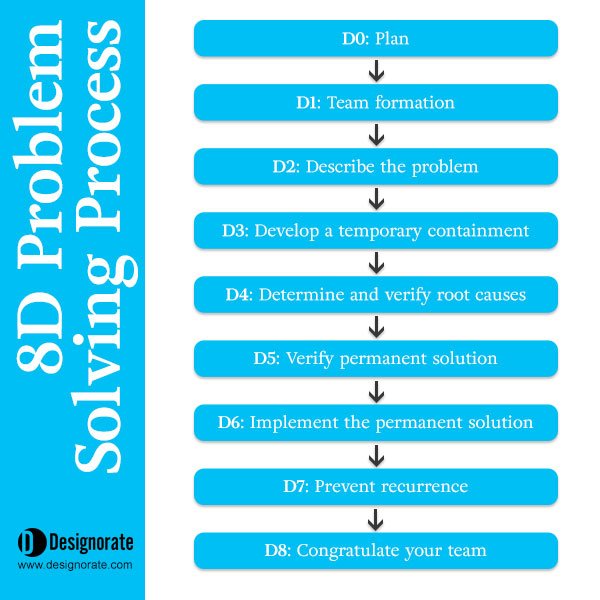
How to Apply the 8D Problem Solving Process?
The steps below form the 8 Discipline process to achieve targeted problem solving through the eight steps.
This discipline is also known as the Pre 8D because it aims to understand the problem and determine if the 8D process is the correct method to use. At this stage, the team aims to answer general questions such as:
- Is this a new problem, or has it happened before?
- Is this a recurring problem?
- What is the history of this issue?
- What was the method used to solve the problem before?
At this stage, the target is to learn about the problem’s history and decide if the 8D process is the best tool to solve the problem.
D1: Team Formation
Thinking as a team can produce more efficient solutions than trying to solve a problem alone. The team includes all the stakeholders involved in the situation. The team communicates with each other and performs brainstorming to solve the problem (check Design Thinking Tools: Reverse Brainstorming ). If the team does not know each other, the brainstorming time can be used to learn how to teach members to explore ideas together. Methods can be used in brainstorming sessions such as mind mapping , Six Thinking Hats , and Lego Serious Play.
D2: Describe the Problem
After team formation, the second step is to understand the problem and its risks. This stage starts with a risk analysis to identify the situation and how it can affect the project flow. Several methods can be used to analyse the problem from different perspectives, including SWOT analysis , SCAMPER technique , and similar tools. This stage is essential to building a clear vision of the problem and ensuring all stakeholders have the same understanding of the situation.
D3: Develop a Temporary Containment Plan
While solving the problem, there should be a temporary containment plan to prevent the problem from affecting the rest of the project or the final product. This temporary containment solution is a short-term operation such as adding more labour, increasing the quality measurements, applying a risk plan, etc.
It is essential to understand that the containment action is not the real solution and can only be used for the short term. Therefore, this action can be applied internally and not affect the process of reaching a permanent solution.
D4: Determine and Verify Root Causes
This stage aims to investigate the root causes of the problem; it can be considered the core of the 8D problem solving process. In many problems, what we see as causes are symptoms of other root causes. This misunderstanding can lead to inaccurate attempts at solutions that can have negative consequences in the future and leave the underlying problem unsolved.
An intensive investigation should be implemented because, in many cases, the root cause is hidden inside the process and covered by many symptoms, which is confusing. Some tools can be used to define the root causes of the problem, such as brainstorming , statistical analysis, flow charts, audits, etc.
D5: Verify the Permanent Solution
Once the root cause is defined, the solution becomes apparent, and the team better understands how to solve the problem. However, the symptoms and other related factors may create difficulties deciding how best to apply the solution. So, these other factors should be considered when determining the permanent solution to the dilemma.
When choosing the permanent solution to the problem, it should meet the following criteria to ensure it is the ideal solution for the problem:
- The solution should be practical
- The solution should be feasible
- The solution should be cost-effective
- The solution should not fail during production
- The solution should be implemented in all affected facilities in the company
D6: Implement the Permanent Solution
Once the solution is approved, this step tends to work as an action plan. This plan aims to outline the steps to implement the solution. It is common to ask questions in this stage: What should be done? Who should be involved in the correction plan?
More documentation and detailed plans should be created if the solution is complex and needs further procedures. The method may include training the team and checking the plan’s progress for further development and improvement.
D7: Prevent Recurrence
Once the action plan is set and ready to be implemented, the team should establish a plan to prevent the problem from occurring in the future. The action plan should be tested and documented as part of the process to avoid the recurrence of the problem. Some of the tools that can achieve this goal are Control Charts, Capabilities Analysis, and Control Plans.
D8: Congratulate the Team
After completing the task and implementing the solution, the team deserves an acknowledgement of their work and a celebration. This event will positively impact the stakeholders and reflect recognition of employees’ efforts from the management inside the company.
How do you Write an 8D Report?
The primary documentation used in the problem solving process is the 8D report. Korenko et al. (2013) presented an example of the 8D problem-solving application, Application 8D Method For Problems Solving . After this example, you can find a free 8D Report template that you can download and use for both commercial and noncommercial applications. The first part of the report, D0, includes information about the problem and the project details related to the project. D1 section contains details of the team involved in the project, roles, titles and contact information. D2 part of the report includes a detailed description of the problem and possible visual images to show the problem clearly. The report can consist of the type of damage of the failure and the function where the problem occurs (Figure 2).
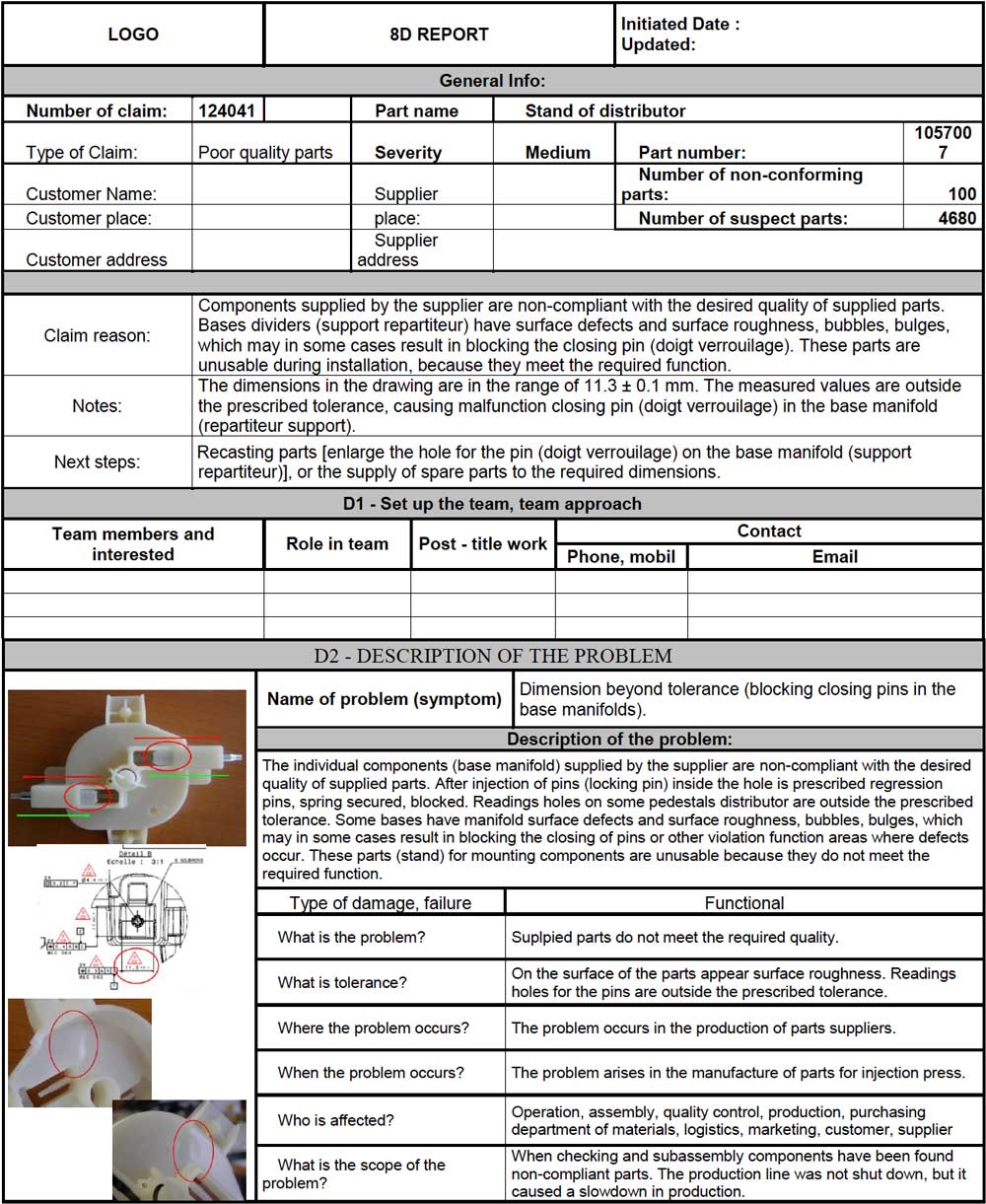
D3 includes details of the temporary solution for the problem required to stop the damage rapidly. In this part, the temporary remedy is described, particularly the symptoms affect, the responsibility, and the validation of the action. In D4, the team uses a root-cause method such as the 5WHYs or the Cause-Effect analysis (Fish Bone method). These methods help the team to identify the root causes of the problem. In Figure 3, the 5WHYs method is used several times to identify the root cause of the problem.
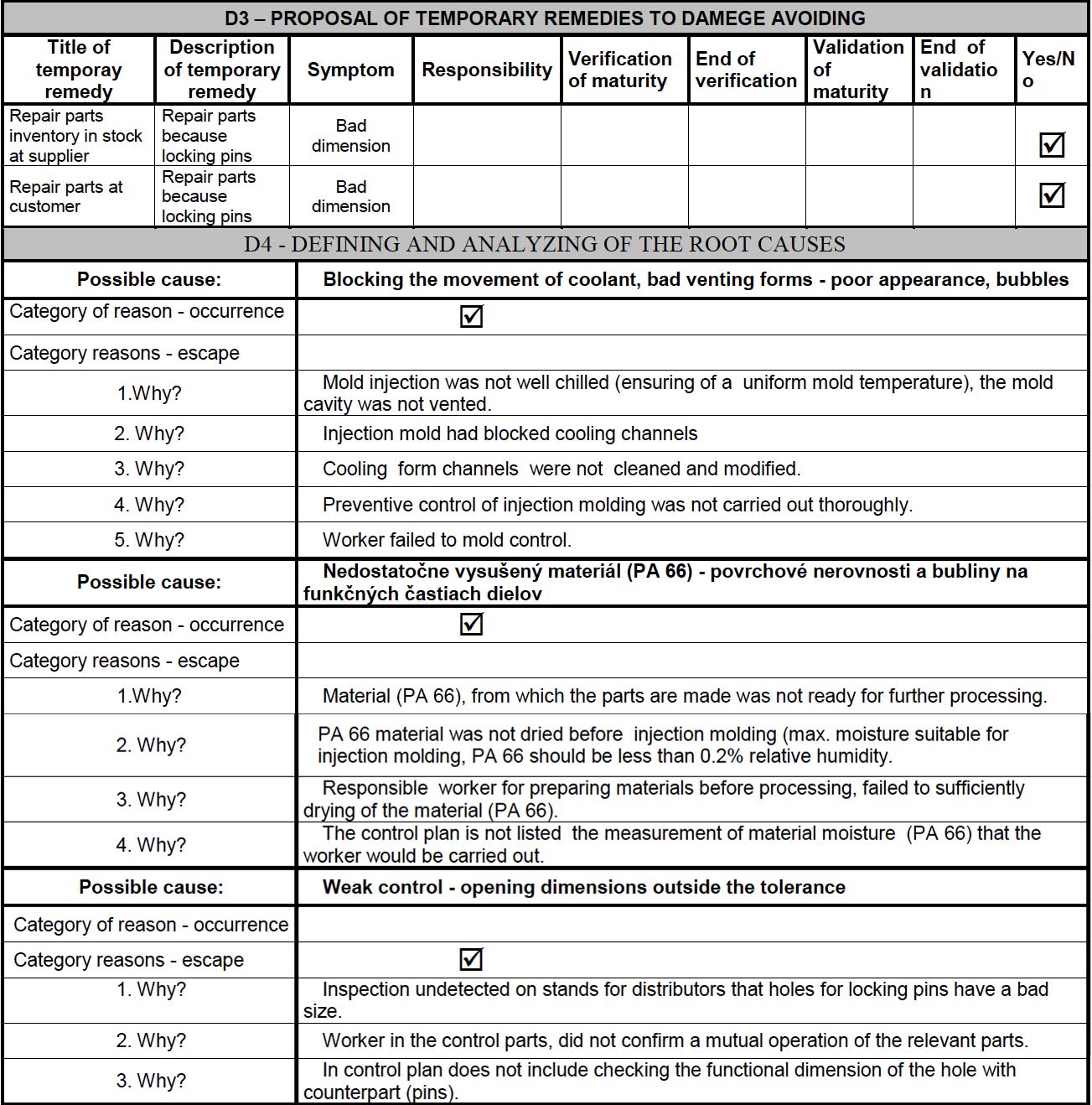
D5 of the report provides details about the permanent solution to fix the problem. Unlike the temporary solution, this aims to element the root causes of the problem. This section includes the procedure’s name, the reason to use it, the responsibility, the management approval to apply it and the expected date of completing the utilisation of the solution, as seen in Figure 4. In the following stage, D6, the team provides details on the implementation and validation of the permanent action.
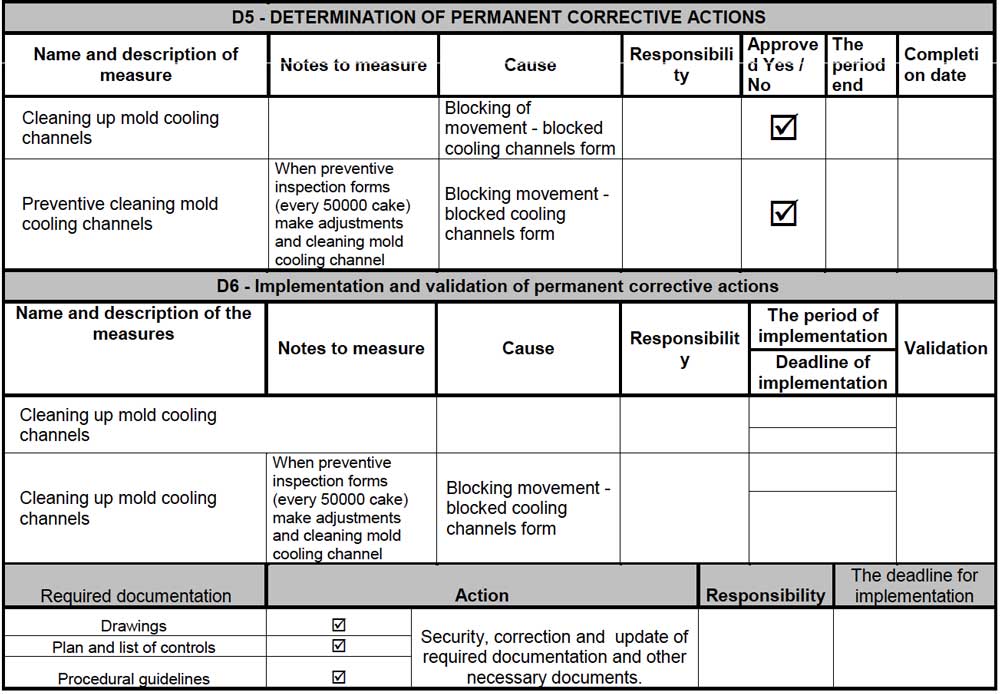
D7 provides details about preventing the recurrent problem, such as the name of the action after the validation process in the previous stage. Also, this stage provides details of the cause behind this action and elements about its responsibility and implementing details. Finally, in D8, the report includes a summary of the procedure and the proper approvals related to the procedure implementation (Figure 5).
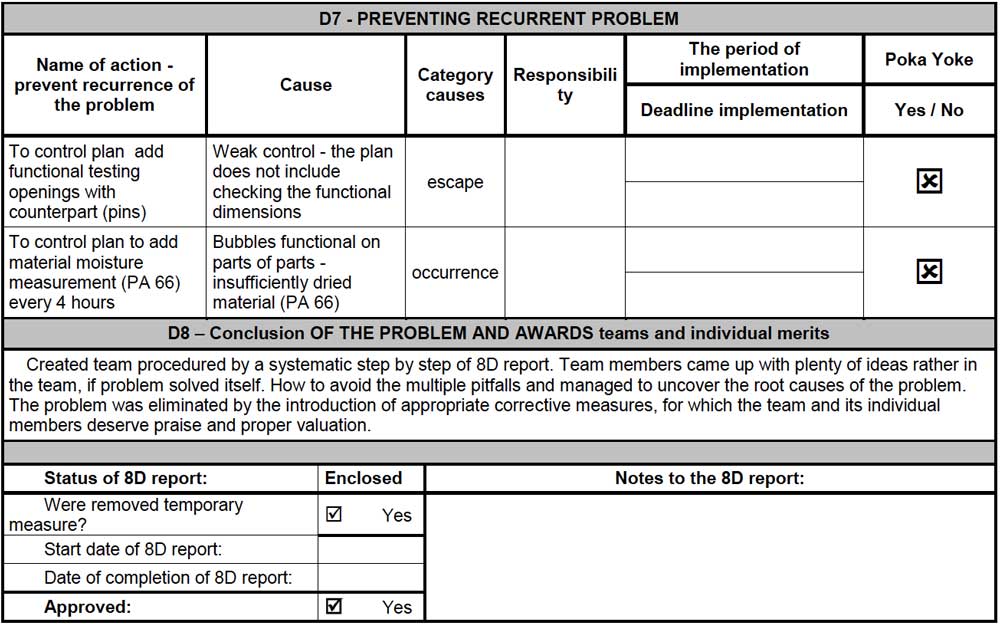
Free 8D Report Template Download

You can download the below 8D report, which you can use for commercial and noncommercial projects. Don’t forget to mention Designorate as the source of this free 8D report.
The 8D Problem Solving process provides a reliable and systematic method that ensures that the problems inside a company or project are solved by eliminating their root causes and preventing recurrence. However, it is most suitable for complex problems that can take weeks or even months to solve. Therefore, the first stage aims to determine if the 8D process is ideal for the problem or if more straightforward tools should be implemented. If the 8D problem solving method is appropriate for your business problem, you have a step-by-step template to guide you through your attempts to find a suitable solution to the obstacle you need to overcome.
Wait, Join my Newsletters!
As always, I try to come to you with design ideas, tips, and tools for design and creative thinking. Subscribe to my newsletters to receive new updated design tools and tips!
Dr Rafiq Elmansy
As an academic and author, I've had the privilege of shaping the design landscape. I teach design at the University of Leeds and am the Programme Leader for the MA Design, focusing on design thinking, design for health, and behavioural design. I've developed and taught several innovative programmes at Wrexham Glyndwr University, Northumbria University, and The American University in Cairo. I'm also a published book author and the proud founder of Designorate.com, a platform that has been instrumental in fostering design innovation. My expertise in design has been recognised by prestigious organizations. I'm a fellow of the Higher Education Academy (HEA), the Design Research Society (FDRS), and an Adobe Education Leader. Over the course of 20 years, I've had the privilege of working with esteemed clients such as the UN, World Bank, Adobe, and Schneider, contributing to their design strategies. For more than 12 years, I collaborated closely with the Adobe team, playing a key role in the development of many Adobe applications.
You May Also Like

4 Service Design Tools to Focus on Consumers’ Needs

How to Use Task Analysis Grid in Service Design

A Guide to the SCAMPER Technique for Design Thinking

Top Resources to Learn Design Thinking Online

How to Use the Decision Matrix to Make Decisions?

30+ Distance Learning Tools And Advices for Design Educators
Leave a reply cancel reply.
Your email address will not be published. Required fields are marked *
Sign me up for the newsletter!

8D Chess: How to Use The 8 Disciplines for Problem Solving
Hospitals have developed something of a reputation for being rife with bad processes . When processes aren’t adequate, the result is an abundance of “workarounds”.
For example, when equipment or supplies are missing, a nurse might waste time running around searching for what is needed, and once the item is found, return to their previous duties.
One study indicates that nurses spend 33 minutes of a 7.5-hour shift completing workarounds that are not part of their job description.
This may well “put out the fire” so-to-speak, but really it is just a hastily applied band-aid that does nothing to treat the root cause of the problem.
More time is wasted and more problems will arise in the future because nothing has been done to prevent the initial problem from happening again.
Individual nurses are not at fault here; workplace culture often values expertise in the form of those who “get the job done”, which tends to pull against the notion of spending time building good processes (time in which the job is perhaps not “getting done”).
So how to approach the problem of problem solving ?
In a lean context, problem solving can be distilled into two simple questions:
- What is the problem and how did it happen?
- How can we make sure that it doesn’t happen again?
The 8D, or eight disciplines methodology, is a problem solving process – most likely one of the most widely used problem solving processes out there. It is used by many different countries, in many different industries, and many different organizations.
8D is designed to help you put out those fires, and make sure they don’t happen again.
In this article, I’ll introduce you to the 8D problem solving methodology and provide you with an outline of the basic process that you can hopefully apply in your own business, plus how you can enhance 8D with other tools and methodologies like Six Sigma , FMEA , and Process Street .
Here’s what I hope you’ll take away after reading:
- An understanding of the basics of 8D
- Advantages of using 8D
- The purpose and objectives of each phase of the 8D process
- An understanding of how to use 8D for problem solving
- How 8D works with other problem solving tools
- How you can use Process Street to maximize the potential of the 8D framework
Let’s begin with the origins of 8D – what is it, and where did it come from?
What is 8D?
8D (sometimes Global 8D or G8D) stands for eight disciplines, and is a problem solving methodology. It’s basically a process for understanding and preventing problems.
Much like how risk management seeks to take a proactive, preventative stance, 8D aims to gain insight into the root causes of why the problems happen, so they won’t happen again.
The 8D process involves eight (sometimes nine) steps to solve difficult, recurring problems. It’s a transparent, team-based approach that will help you solve more problems in your business.
8D origins: Where did it come from?

Despite the popular story that 8D originated at Ford, it was in fact developed in 1974 by the US Department of Defence, ultimately taking the form of the military standard 1520 Corrective Action and Disposition System for Nonconforming Material .
Ford took this military standard, which was essentially a process for quality management , and expanded on it to include more robust problem solving methods.
In 1987, Ford Motor Company published their manual, Team Oriented Problem Solving (TOPS) , which included their first iteration of the 8D methodology.
Initially termed Global 8D (or G8D) standard, it is currently used by Ford and many other companies in the automotive supply chain.
8D, PDSA, & other problem solving processes
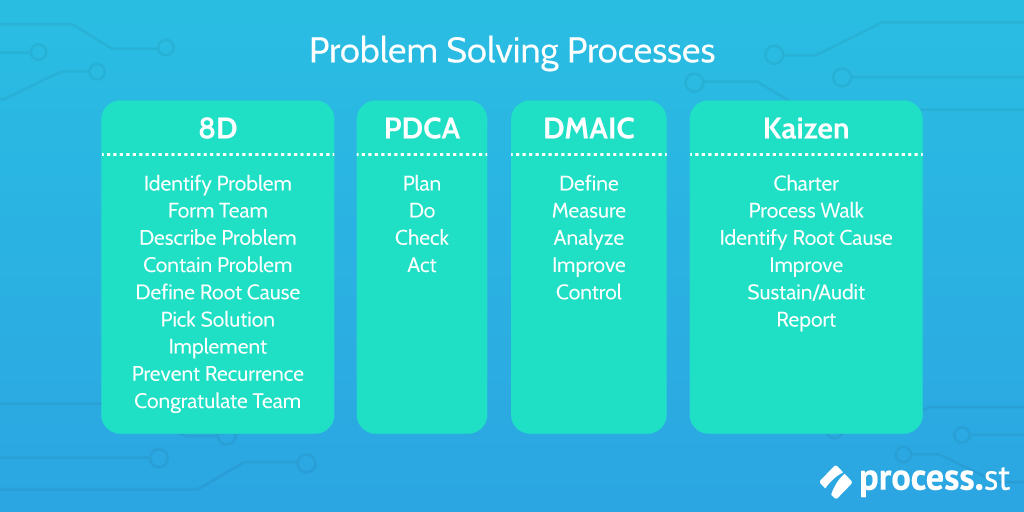
The disciplines of 8D follow the same logic as the Deming Cycle (also known as PDSA, and sometimes PDCA).
PDSA stands for Plan, Do, Study, Act (or Check, in the case of PDCA).
The similarity lies in the fact that both PDSA and 8D are designed to be used to improve processes. They’re both examples of cycles of continuous improvement.
Whereas 8D may be painted as a more generic problem-solving framework, structurally speaking both 8D and PDSA share a lot in common.
The simple idea of beginning with a clear objective, or desired output, and then testing, analyzing , and iteratively tweaking in a continuous cycle is the basis for both methodologies.
There are, of course, differences. We’ll cover the different applications of both 8D and PDSA in this article.
8D advantages

One of the main strengths of 8D is its focus on teamwork. 8D philosophy encourages the idea that teams, as a whole, are more powerful than the sum of the individual qualities of each team member.
It’s also an empirical methodology; that is to say that it is a fact-based problem solving process.
A branch of continuous improvement, proper use of 8D will help you coordinate your entire team for effective problem solving and improved implementation of just about all of the processes used in your business.
The 8 disciplines for problem solving
As you may have noticed, we’re starting with zero, which makes nine total disciplines. This “zero” stage was developed as an initial planning step.
D0: Plan adequately
Make comprehensive plans for solving the problem including any prerequisites you might determine.
Be sure to include emergency response actions.
D1: Establish your team
Establish your core team with relevant product or process knowledge. This team will provide you with the perspective and ideas needed for the problem solving process.
The team should consist of about five people, from various cross-functional departments. All individuals should have relevant process knowledge.
A varied group will offer you a variety of different perspectives from which to observe the problem.
It is advisable to establish team structure, roles, and objectives as far ahead in advance as possible so that corrective action can begin as quickly and effectively as possible.
D2: Describe the problem
Have your team gather information and data related to the problem or symptom. Using clear, quantifiable terms, unpack the problem by asking:
D3: Contain the problem (temporary damage control)
Depending on the circumstances, you may need to mobilize some kind of temporary fix, or “firefighting”.
The focus of this stage should be on preventing the problem from getting worse, until a more permanent solution can be identified and implemented.
D4: Identify, describe, and verify root causes
In preparation for permanent corrective action, you must identify, describe, and verify all possible causes that could contribute to the problem happening.
You can use various techniques for this, including a Failure Modes and Effects Analysis , or Ishikawa (fishbone) diagram .
It’s important that the root causes are systematically identified, described in detail, and promptly verified (or proved). How each cause is verified will depend on the data type and the nature of the problem.
Take a look at the section towards the end of this article for some more problem solving tools to help you decide the right approach.
D5: Identify corrective actions
You must verify that the corrective action you identified will in fact solve the problem and prevent it from happening again in the future (or whatever is your desired threshold of recurrence).
The best way to do this is to collect as much data as possible and by performing smaller-scale “pilot” tests to get an idea of the corrective action’s impact.
You can’t begin to identify the optimal corrective action until you have identified the root cause(s) of the problem.
D6: Implement and validate corrective actions
Carry out the corrective actions, and monitor short and long term effects. During this stage, you should assess and validate the corrective actions with empirical evidence.
Discuss and review results with your team.
D7: Take preventative measures (to avoid the problem happening again)
Here is where you make any necessary changes to your processes, standard operating procedures , policies , and anything else to make sure the problem does not happen again.
It may not be possible to completely eliminate any chance of the problem recurring; in that case, efforts should focus on minimizing possibility of recurrence as much as possible.
D8: Congratulate your team
It’s important to recognize the joint contribution of each and every one of the individuals that were involved in the process.
Team members should feel valued and rewarded for their efforts; this is crucial and perhaps the most important step – after all, without the team, the problem would not have been fixed.
Providing positive feedback and expressing appreciation helps to keep motivation high, which in turn improves the sense of process ownership and simply increases the likelihood your team will actually want to improve internal processes in the future.
How to use 8D for problem solving
The 8D method above outlines a proven strategy for identifying and dealing with problems. It’s an effective problem solving and problem prevention process.
In addition to avoiding long-term damage from recurring problems, 8D also helps to mitigate customer impact as much as possible.
More than just a problem-solving methodology, 8D sits alongside Six Sigma and other lean frameworks and can easily be integrated with them to minimize training and maximize efficacy.
8D is definitely a powerful framework on its own, but it really shines when combined with other synergistic concepts of lean and continuous improvement.
More problem solving tools that synergize well with 8D
8D has become a leading framework for process improvement, and in many ways it is more prescriptive and robust than other more simplistic Six Sigma approaches.
However, there are many Six Sigma methodologies, and even more frameworks for problem solving and process improvement .
The following improvement tools are often used within or alongside the 8D methodology.
DMAIC: Lean Six Sigma
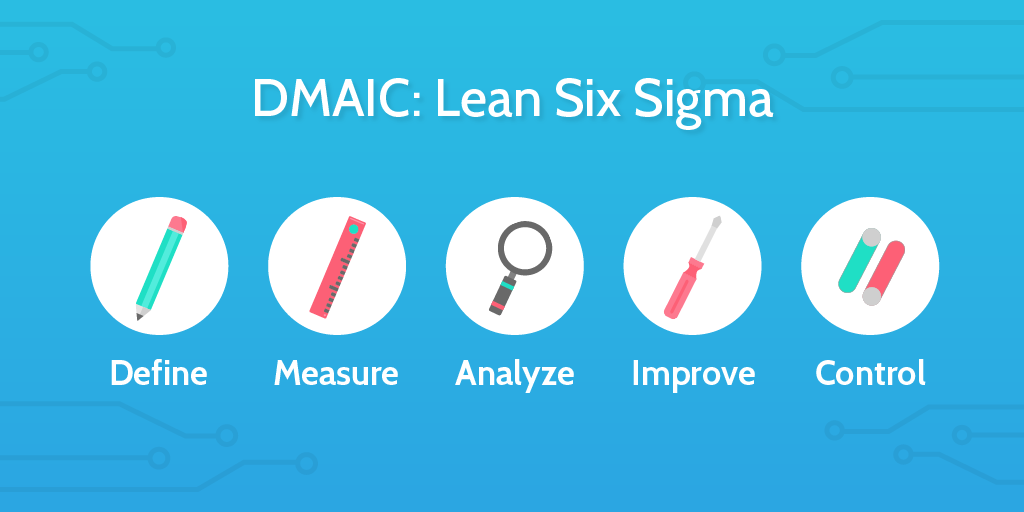
DMAIC stands for:
The DMAIC process is a data-driven cycle of process improvement designed for businesses to help identify flaws or inefficiencies in processes.
Simply put, the goal with DMAIC is to improve and optimize existing processes.
Interestingly, the development of the DMAIC framework is credited to Motorola , whose work built upon the systems initially developed by Toyota .
In terms of working alongside 8D, you could use DMAIC to identify root causes as in D4; you could also implement the same techniques to better understand prospects for corrective actions as in D5, and D6.
We have a whole article on the DMAIC process, if you’re interested.
SWOT analysis

Strengths, Weaknesses, Opportunities, and Threats. You can use a SWOT analysis to gain insight into your organization as a whole, or on individual processes.
The main synergy with 8D is in the identification of opportunities, threats, and weaknesses.
These can represent opportunities for process improvements, weaknesses in your process that could produce problems further down the line, and threats, both internal and external, that may be out of your direct control but that could cause problems for you.
Here’s a SWOT analysis checklist you can use to structure your own analysis:
FMEA: Failure Mode and Effects Analysis

FMEA (Failure Mode and Effects Analysis) is a way of understanding the potential for problems and making preemptive preparations in order to avoid them. It is a method of risk management .
It is a type of preventative risk management process, and so works well in the context of identifying causes of problems so you can better deal with them.
FMEA and 8D work well together because:
- 8D can make use of information gathered during an FMEA process, like brainstorming sessions, to identify potential problems and their root causes.
- You can reuse possible cause information gathered during an FMEA process to feed into different representational diagrams like the Ishikawa (fishbone) diagram, which will help in the 8D process.
- 8D brainstorming data is useful for new process design. This allows the FMEA to take actual process failures into account, which produces more effective results.
- FMEA completed in the past can be used as databases of potential root causes of problems to inform 8D process development.
Here’s a free FMEA template for you to get started ASAP:
The Pareto Chart
The Pareto Chart helps us understand the impact of different variations of input on our output.
In relation to 8D, Pareto Charts can help us prioritize which root cause to target, based on which will have the greatest impact on improvement (where improvement is the desired output of the 8D process).
Here’s the Six Sigma Institute’s example Pareto Chart :
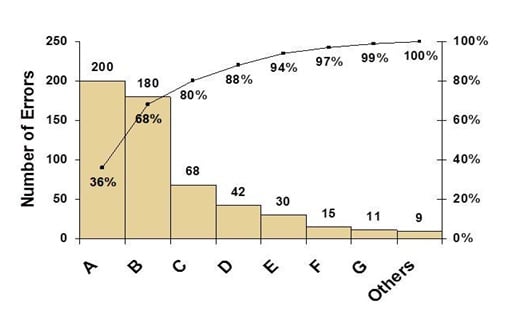
Here we have a simple deductive reasoning technique that asks “why?” five times to dig into the root cause of a problem.
The logic here is that by asking the same question five times, you work progressively “deeper” into the complexity of the problem from a single point of focus.
Ideally, by the fifth question you should have something that has a high likelihood of being a root cause.
This example from Wikipedia does a great job of conveying how the process works:
- The vehicle will not start. (the problem)
- Why? – The battery is dead. (First why)
- Why? – The alternator is not functioning. (Second why)
- Why? – The alternator belt has broken. (Third why)
- Why? – The alternator belt was well beyond its useful service life and not replaced. (Fourth why)
- Why? – The vehicle was not maintained according to the recommended service schedule. (Fifth why, a root cause)
Ishikawa diagrams (fishbone diagrams)
Sometimes called “cause-and-effect diagrams”, they are as such used to visualize the cause and effect of problems.
The approach takes six different categories and places information about the problem into different categories to help you understand what factors could be contributing to the problem.
One advantage over the 5 Whys approach is the way this method forces a more holistic perspective, as opposed to the potentially narrow vantage point offered by zooming in on a single aspect or question.
According to the Six Sigma Institute, the 6 key variables pertaining to root causes of problems are:
- Machine: Root causes related to tools used to execute the process.
- Material: Root causes related to information and forms needed to execute the process.
- Nature: Root causes related to our work environment, market conditions, and regulatory issues.
- Measure: Root causes related to the process measurement.
- Method: Root causes related to procedures, hand-offs, input-output issues.
- People: Root causes related people and organizations.
There’s also this useful illustration of a company using a fishbone diagram to better understand what factors contribute to a company’s high turn around time.
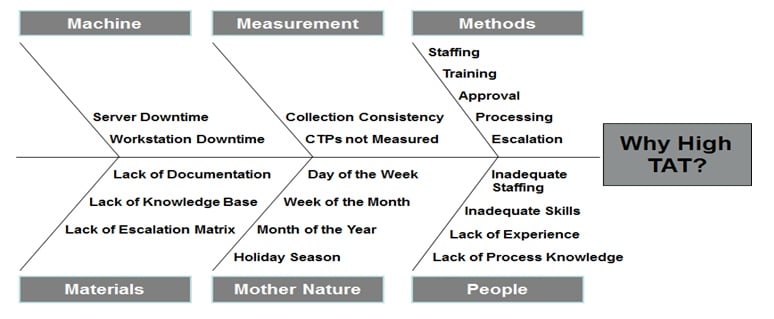
Gap analysis

A gap analysis is concerned with three key elements:
- The current situation, or “performance”
- The ideal situation, or “potential”
- What needs to be done in order to get from performance to potential, or “bridging the gap”
The “gap” is what separates your current situation from your ideal situation.
Businesses that perform a gap analysis can improve their efficiency and better understand how to improve processes and products.
They can help to better optimize how time, money, and human resources are spent in business.
There’s a lot that goes into a gap analysis, and quite a few different ways to approach it. Check out our article for a deeper dive into the gap analysis process.
Superpowered checklists
Checklists can be a great way to simplify a complex process into a series of smaller, easy-to-manage tasks. They’re one of the best ways to start using processes in your business.
By using checklists, you can reduce the amount of error in your workflow , while saving time and money by eliminating confusion and uncertainty.
What’s more, if you’re using Process Street, you have access to advanced features like conditional logic , rich form fields and streamlined template editing .
How to use Process Street for 8D problem solving
Good problem solving relies on good process. If you’re trying to solve problems effectively, the last thing you want is your tools getting in your way.
What you want is a seamless experience from start to finish of the 8D methodology.
The best kinds of processes are actionable. That’s why you should consider using a BPM software like Process Street to streamline recurring tasks and eliminate manual work with automation .
Process Street’s mission statement is to make recurring work fun, fast, and faultless. By breaking down a process into bite-sized tasks , you can get more done and stay on top of your workload.
Sign up today for a free Process Street trial!
Problem solving is an invaluable skill. What’s your go-to process for problem solving? We’d love to know how it compares with the 8D method. Let us know in the comments!
Get our posts & product updates earlier by simply subscribing
Oliver Peterson
Oliver Peterson is a content writer for Process Street with an interest in systems and processes, attempting to use them as tools for taking apart problems and gaining insight into building robust, lasting solutions.
Leave a Reply Cancel reply
Your email address will not be published. Required fields are marked *
Save my name, email, and website in this browser for the next time I comment.
Take control of your workflows today

No Problem at All: Diagnosing the 8 Disciplines of Problem Solving
When problems appear, discipline is vital. Disciplines also help, and the eight disciplines of problem-solving (also referred to as the 8Ds) offer a proven process improvement structure that provides a framework for identifying root causes, eliminating them, and preventing reoccurrence.
The enduring popularity of the 8Ds attests to their power. It’s a tried and tested format on which you can rely — no matter what has gone wrong elsewhere.
How the 8 Disciplines of Problem Solving Evolved
In the 1980s, the Ford Motor Company published its manual, Team Oriented Problem Solving (TOPS), the first articulation of the 8Ds. Eventually, it refined the original procedures into the current 8Ds.
Ford also added an initial planning stage (D0). There are now nine steps of 8D. Fortunately, the actual process is more intuitive than its numbering.
Initially developed for the auto industry, the 8D problem-solving process has been successfully adopted across multiple industries, including healthcare, government, finance, retail, and manufacturing.
How 8D Can Help You
The benefits of 8D include:
- More effective and efficient problem solving
- A team-oriented approach
- Open communication within the team and with management
- A framework for corrective action that allows for systemic changes and continual improvement
- Intense examination of the control systems that permitted the problem
- Easy integration with process-improvement tools
You can apply the 8Ds whenever processes break down. Engineers and manufacturers often turn to them when they receive customer complaints or discover safety or regulatory issues. They also come in handy when a system’s amount of waste or a product’s failure rates hit problematic levels.
What Are the 8 Disciplines of Problem Solving?
The 8Ds provide a methodical approach to problem-solving. The sequence of nine steps will take you from the initial discovery of an issue to your celebratory toast when you fix it.
The designers added a planning stage to the original 8D methodology. This stage focuses on the one following, bringing clarity and intention to the project.
Summarize the Issue
You’ll describe it in greater detail later, but you’ve started this process because you identified a problem. What is it?
Collect the information on the problem’s symptoms and identify apparent gaps or additional needs. You might also want to consult a subject matter expert and get their input on your issue. They may be able to save you time further down the road.
Identify and Take Emergency Responses
If your house is on fire, put it out. Then you can take a hard look at the wiring.
As soon as you’ve identified a problem, take any necessary action to limit or contain a dangerous situation. Don’t overreact or prematurely make uncertain changes. Just exercise common sense.
Plan for the 8Ds
Your actual project plan will change as you make discoveries. This document is simply an outline of the project’s space within your company. It’s a theory about the necessary investment of time and other scarce resources.
Identify the resources you have and need. Sketch out schedules and note the variables that will affect them.
D1: Form Your Team
Create a team to tackle the problem.
Add the Right People
The group should be small enough to be efficient but large enough to cover all necessary process/product knowledge and technical skills. Some recommend a team of about five members. Make sure this team has the necessary authority and allotted time they need.
Identify both a team leader and a project champion in management (if necessary). Establish guidelines for harmonious group work.
This is also the time to perform team-building exercises if you want.
Review the Problem
Get team members up to date and fully on board. Review the initial brief for the project and discuss scope and priorities. Team members should all have the opportunity to voice initial concerns and complications.
D2: Define and Describe the Problem
Outline the problem in as much detail as possible, using quantifiable terms. Clarify both what the problem is and is not . The latter will help you begin eliminating potential reasons for failure.
As you define the problem, you should also understand whether your situation is “something changed” or “never been there.” Has something gone off course, or has a new variable or context appeared?
Identify Critical Process Steps
Create a flowchart for the flawed process, and indicate which steps are critical to the problem at hand. In this step, you will start to approach root cause analysis, though you won’t isolate and verify a root cause until D4.
Outline Project Plan
At this point, you will develop a more detailed, high-level project plan that includes milestones, objectives, and a fuller schedule.
D3: Contain the Problem
D3 focuses on interim containment action rather than permanent and preventive action.
This step isn’t about emergency action, which should have been taken already. You’ve put out the house fire, but you still need to lodge your tenants elsewhere while your electricians go through the place.
Find a Temporary Solution
Take whatever action is necessary for the satisfaction of your customers or the effectiveness of your organization. You may need to develop workarounds, issue (non-emergent) recalls, or establish a resource for affected customers.
The ideal interim solution is:
- Inexpensive
- Simple and quick to implement
- Easy to reverse
- Validated by customer or employee feedback
When you’ve realized your long-term solution, you can do away with interim measures.
D4: Find the Root Cause
Root cause analysis is at the heart of most problem-solving tools and processes. It’s time to dig deep into the problem and find out what’s gumming up the works.
Develop Root Cause Theories
You’ll complete the process of elimination that you began when defining the problem. Refer to your flowchart. What could be causing the problem?
Use root cause analysis tools like the Fishbone Diagram and the five whys . Find all possible factors that could contribute to the breakdown.
Test and Review Causes
Test each of your potential causes, collecting data until you can rule out all but one.
Identify Escape Point
In addition to finding the root cause, you need to figure out what part of the control system allowed it to escape detection and be contained. Find the point where someone or something should have caught the issue. That’s the escape point.
Correctly identifying and solving escape-point issues is essential to preventing future problems.
D5: Identify and Test Solutions
You’ve found the problem and its escape point. Of course, that’s only half the battle. Now you need to solve them — permanently and completely.
Define what “solved” looks like. Is there a threshold of minimum acceptability?
Develop Solutions
Give your team the time to consider potential approaches to both the root cause and escape point issues. The first idea may not be the best, and brainstorming tools such as affinity diagrams can help.
Test Solutions
Make sure they work. You should also perform risk and cost analysis for any final contenders.
D6: Choose Solutions and Put Them Into Practice
Choose your best solutions, outline your implementation plan, and move forward with it. Both management and team members should sign off on the solution.
Implement, Validate, Monitor
After putting your plan into practice, check with customers and stakeholders to ensure that their concerns are fully addressed. Continue to monitor the situation to make sure the solution is sustainable and effective. You’ll also keep an eye out for any unintended consequences.
Move From the Interim to the Permanent Solution
Once you have the permanent solution up and running, you can end interim measures.
D7: Prevent Recurrence
By addressing the escape point and continuing to monitor the situation, you’re doing a fair amount to prevent an exact recurrence. But make sure that all contributing systems have been updated to reflect new input.
You should also preserve all documentation so that future teams have it as a resource for similar problems. Even better, prevent those similar problems.
Improve and Standardize Systems Across the Organization
Are there analogous areas of the organization that could use review? Are their policies and procedures in line with those you’ve developed?
Conduct an audit of operational procedures, management processes, and training manuals.
D8: Celebrate and Recognize Contributions
You’re not done quite yet. Recognition and validation are vital for a healthy organization, so take time to acknowledge individual contributions and the team’s accomplishments.
Perform a Final Review
Look at team output with a focus on before-and-after results. Finalize documentation and add it to the company library.
You should also take the time to reflect on your 8D experience. Explore trouble spots or areas that could use clarification for the next problem-solving team.
Reward your team appropriately. This can include anything from company-wide emails to dinner to bonuses. Even a personal email goes a long way toward making people feel like valued members of a community.
Then Do It All Again
When you make the eight disciplines of problem-solving part of your organizational DNA, you prepare to solve all kinds of problems in a streamlined, effective way.
The 8Ds integrate seamlessly with the Six Sigma methodology and make a great addition to your toolkit.
Discover your potential savings with our ROI Calculator
8D Management (8 Disciplines Management)
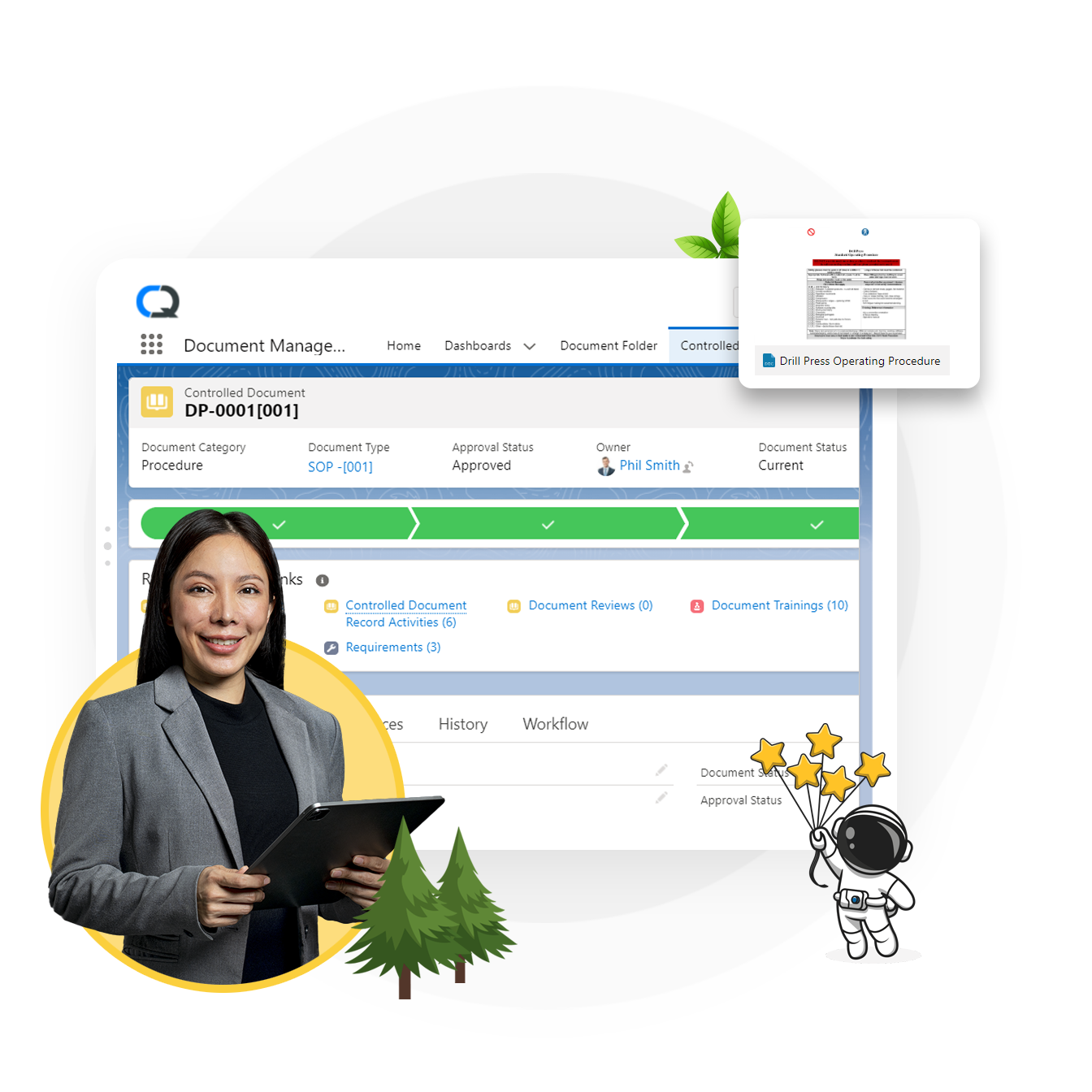
8D Management & The 8D of Problem Solving
Problems are a part of life and a business is no exception. Even with the best of intentions and systems, some errors can creep in and be hard to detect. It may be nothing serious or can have serious repercussions such as reputation damage, heavy fines, product recall, property loss, and so on. It becomes essential to identify the problem, its consequences on the one hand, and causes on the other to be able to not only resolve it for now but also ensure prevention of its recurrence. One of the methodologies, popular amongst engineers and professionals mainly in the automotive industry but now applied across several industries is the eight disciplines (8D) model. It helps to identify, correct, and eliminate recurring problems, affecting improvement in product and process.
Related Assets
Whenever organizations tackle problems and generate solutions based out of root cause analysis, they tend to generate a lot of…
Key Highlights: 8D is an extremely effective, proven problem-solving framework, especially in the manufacturing and automotive sector. However, to truly…
From a quality management standpoint, a problem may be reported in an organization from one of the following processes: Complaints…

What is 8D?
The 8D is a systematic, holistic and proven methodology designed to identify the root cause of a problem, plan a quick fix, and implement corrective actions and preventive actions to avoid their recurrence. If your product is defective or not meeting your customer requirements, then 8D is an excellent first step to improve Quality and Reliability.
One of the core parts of introducing 8D problem solving, greatly accepted by most disciplines of industries, and having huge effectiveness levels in improving product and process quality, would be 8D (Eight Disciplines). Key steps in the 8D methodology are forming a team, defining the problem, identifying and implementing interim containment, identifying the root causes, implementing and verifying permanent corrective actions, and avoiding future recurrence of problems. The 8D process for root cause analysis concludes by highlighting that the team members not only play a vital role but also recognizes them, hence reinforcing that this approach is a collaborative one. 8D has become very popular among manufacturers, assembly, and services around the globe because it is effective and comparatively easy to teach.
Introduction to 8d Problem Solving
The 8D approach to problem-solving, also known as the 8D methodology, is a systematic and comprehensive method used to address and resolve complex issues, particularly in manufacturing and other industries.
This 8D troubleshooting methodology involves a structured process designed to identify, correct, and prevent issues, ensuring that similar problems do not occur in the future.
By following the 8D process steps, teams can effectively perform root cause analysis and implement corrective actions.
The 8D structured problem-solving process is highly valued for its ability to provide a clear framework for identifying and eliminating the root cause of a problem, thereby enhancing overall operational efficiency.

Why to Apply 8D Problem Solving Methodology?
The 8D methodology, developed to represent the best practices in problem solving, provides the engineering teams with an effective and efficient team-oriented problem solving skill, a better understanding of Root Cause Analysis (RCA) and how to use basic statistical tools required for problem solving. 8D helps the management understand and resolve problems better, identify necessary systemic changes and inputs for change , and facilitate a more candid and open communication in problem solving discussions.
8D improves the Quality and Reliability of your products, and if performed correctly, prepares the engineering team for future problems.
When to Apply 8D Problem Solving Process?
The 8D problem solving process is used to solve major, critical, chronic, and recurring problems. The 8D is typically required during safety or regulatory issues, customer complaints , warranty concerns, poor performance or test failures, internal rejects, and to minimize waste and scrap.

How to Use Root Cause Analysis to Transform Your Safety Program
8d problem solving approach.
The 8D is a systematic process for the introduction and improvement of quality, and elimination of problems. Here we will show you the step by step approach of the problem solving tools that can make you proficient at identifying causes of problems, defining problems, and errors. Additionally, it helps identify root causes and take actions to solve and prevent identified problems in processes. So, let’s take a peep inside:

D0: Planning and preparing for the 8D
Proper planning and preparation are always a good start before taking any action. So, you need to consider the following before forming a team:
- Problem description
- Timeframe for the resolution
- The number of resources to accomplish this

D1: Team establishment
Create a team with people who varied backgrounds and experiences which will lead to the best quality inputs and a complete solution. For the team to function smoothly, define clear roles, and responsibilities for your people, and have a team leader.

D2: Problem description
The 8D method’s primary focus is to describe the problem appropriately and objectively such that it captures all the vital information. During this analysis, repeated 5W1H (why, what, who, where, when, and how) are required to be asked to develop a clear description.

D3: Problem containment plan
A temporary problem containment plan is sometimes needed to minimize the impact of the problem until you develop permanent solutions. On developing the plan based on the hypothetical cases, the resources for addressing the main problem can be released. At times, new processes may be required to work around the problem until you have a permanent fix.

D4: Root Cause Analysis (RCA)
With the problem temporarily contained, you can now turn to identify all of the root causes of the nonconformance . There are several tools to identify the actual root cause of an issue including the 5W1H to understand the problem in-depth, Fishbone diagrams to visually categorize causes, and Pareto charts to identify the vital causes.

D5: Permanent Corrective Action
Once the root cause of the problem is determined, the team can start brainstorming permanent corrections to identify what the best long-term solution will be. Brainstorming sessions combined with tools such as affinity diagrams help organize ideas based on their relationships and determine the best course of action.

D6: Implement and Validate the Permanent Corrective Action
Once the solution is identified, the management needs to implement and verify the corrective action using the PDCA (plan-do-check-act) approach for small-scale testing before large-scale rollout. Thus, the outcomes and corrective actions are tracked to ensure expected results. To successfully implement a permanent change, a project plan should incorporate:
- Development of the project plan for implementation
- Communicating the plan to all stakeholders
- Validating improvements using measurement

D7: Prevent Recurrence
A complete solution of problems means preventing them from occurring. Besides, preventative measures should also be implemented for corrective actions in the 8D methodology. This requires reviewing management processes, operating procedures, and training manuals to ensure that best practices are followed.
At this stage, organizations should consider actions including updating process audit questions and regularly verifying them based on corrective actions to reduce risk in other processes, presenting poka-yoke or error-proofing devices to big-risk processes, and conducting red rabbit tests to see how long it takes poka-yoke devices to detect defective product.

D8: Verification and Team Celebration
Once the problem is solved, the ultimate step is to congratulate the team. It’s important to recognize their efforts and share their success across the organization because teams require feedback to allow for satisfactory closure. This facilitates motivation and employee engagement while helping you improve quality control, execute process improvements, and aid change management as you grow.

Create a team with people who are having varied backgrounds and experiences which will lead to the best quality inputs and a complete solution. For the team to function smoothly, define clear roles, and responsibilities for your people, and have a team leader.

A complete solution of problems means preventing them from occurring initially. Besides, preventative measures should also be implemented for corrective actions in the 8D methodology. This requires reviewing management processes, operating procedures, and training manuals to ensure that best practices are followed.
8D Root Cause Analysis (RCA) and 8D Corrective Action Process
The 8D Root Cause Analysis, as well as the 8D Corrective Action process, is a widely systematic approach in quality management , especially concerning 8D in quality control. This method includes eight comprehensive steps that are devised to problem solving by dealing with root causes of the problems comprehensively. The steps of the 8D process start with the formation of a team, a clear definition of the problem, and move on to interim containment actions. This is then followed by detailed root-cause analysis using the 8D RCA process, development and verification of permanent corrective actions, implementation, and recurrence preventing efforts. Encouraging details in the analysis: the 8D methodology steps encompass collaborative efforts and documentation that ensure durable solutions and continuous improvement in organizational processes. Root Cause Analysis (RCA) is embedded within the 8D process and includes the following steps and techniques:

Problem Symptom is measured and transformed to “Object and Defect”

Problem Symptom is reformed to Problem Statement using the 5W1H process

Potential Causes are gathered using the tools like Fishbone or Affinity Diagram

Problem Statement should fit using both the “is” and the “isn’t” sections of the question

Root Cause concepts are developed from remaining possible causes on the tool and related changes from is/is not

Compare theories with recent data and develop experiments for Root Cause Verification

Test and confirm the Root Causes

Customer Success
3 Women Leaders Making a Powerful Impact in Global Quality and Safety Management
How to use the 8d approach.
8D portrays 8 steps of a structured approach to solve difficult, recurring, or critical problems by providing transparency, driving a team approach, and increasing the chances of solving the problem.
Proper plan for solving the problem and identify the prerequisites.
Team creation
Gather a cross-functional team with product/process knowledge.
Problem description and definition
Use the data and information to specify the problem by identifying in quantifiable terms the who, what, where, when, why, how, and how many (the 5W1H) for the problem.
Problem Containment Plan development
Develop and implement interim actions to eliminate the problem from any customer in the future.
Specify and assess Root Causes
Identify and review all relevant causes and sources of variation that analyze why the problem has occurred and figure out why the problem was not noticed at first using 5W1H or diagrams.
Verify Permanent Solutions
After collecting data confirm that the possible solutions will actually resolve the problem.
Implement and Validate Corrective Actions
Discuss and review results and develop plans to implement the best solutions or countermeasures.
Preventive measures
Transform the operation systems, management systems, procedures, and practices to avoid the recurrence of similar problems.
Compliment your team
Recognize the collective efforts of your team and formally thank them for their involvement.

8D Problem Solving Tools and Techniques
The 8D problem solving methodology is the set of tools and methods aiming for complex quality issues. 8D problem solving techniques are basically comprised of a fishbone diagram, 5 Whys analysis, Pareto charts, process flowcharts, and Failure Mode and Effects Analysis (FMEA) to come to terms with the 8D framework. Integration with statistical tools and data analysis in every step of 8D analysis is sure to make the most accurate identification of the root cause.
This approach would ensure that cross-functional teams' participation would not only be present in the brainstorming sessions but also in the 8D problem solving process at the problem solving stage.

Training in 8D Methodology
8D training is an inevitable imperative that makes its deployment in organizations effective. The 8D methodology provides all the necessary details that the teams could apply to the skills and knowledge required at every step in 8D of quality control . Training the workforce on 8D methodology will make them able to apply these aspects when dealing with real-world problems, which will better off the quality and efficiency of the entire organization. It ensures that all these measures and strategies have been inducted to make sure that 8D problem solving approaches are not just tools for problem solution but have been inducted to lay down the base for sustainable quality improvement and prevention practices in the organizational processes.
How to Enhance Quality and Efficiency in 8D Manufacturing?
Understand the Basics of the 8D Approach to Problem Solving
- Familiarize yourself with the principles of the 8D methodology.
- Recognize that the 8D process steps include team formation, problem
Form a Cross-Functional Team
- Assemble a team with diverse skills and perspectives.
- Ensure each member understands their role in the 8D structured problem solving process.
- Use precise language to describe the problem.
- Implement tools like the 5 Whys to aid in the root cause analysis 8d problem solving phase.
Implement Interim Containment Actions
- Take immediate steps to prevent the problem from worsening.
- Document these actions as part of the 8D troubleshooting methodology
Identify and Verify Root Causes
- Conduct a thorough root cause analysis to pinpoint the underlying issues.
- Utilize techniques like fishbone diagrams and Pareto charts in the 8D RCA process.
Develop Permanent Corrective Actions
- Propose solutions that address the root causes identified.
- Ensure these solutions are sustainable and prevent recurrence.
Validate the Corrective Actions
- Test the solutions to ensure they effectively resolve the problem.
- Collect data to confirm the effectiveness of the root cause analysis and the 8Dd corrective action process.
Implement and Monitor Solutions
- Roll out the verified solutions across relevant areas.
- Continuously monitor the impact to ensure long-term success.
Prevent Recurrence
- Update processes and documentation to incorporate the new solutions.
- Train employees on the new procedures to embed them in daily operations.
Recognize and Celebrate Success
- Acknowledge the efforts of the team in solving the problem.
- Use this opportunity to reinforce the importance of the 8D methodology in maintaining quality and efficiency.
Ensuring compliance with FDA regulations is crucial for medical device manufacturers to maintain market access and ensure patient safety. Medical Device Compliance Software plays a pivotal role in helping companies align with these stringent requirements. Here’s how:
Great product, support, and people to work with!
We have rolled-out CQ across our company to automate various elements of QMS requirements such as Document Management, Complaints, Non-conformances, Corrective Action (8D and A3), Supplier Management and Audit Management. We have been using the software for more than 2 years. We are glad to see how well the system is being used across the company. We have several thousand users on the system currently and working to scale the usage further. CQ solution has been configured to meet our needs, works elegantly across languages, across time zones, and business verticals. With integration between CQ and SAP to exchange critical data, the process automation provides a lot of productivity.
CQ configuration team and support have worked hard to ensure that our needs continue to be met. They consistently go above and beyond. We cannot be more pleased with our use of CQ QMS capabilities and would definitely recommend to anyone who is looking for a modern cloud based EQMS solution especially if you want a scalable EQMS solution.
Lia Budiman, Continental Contitech

8D Process Improvement in Different Industries
Automotive Industry
- Application of 8D Methodology: Essential for addressing recurring quality issues and customer complaints.
- Root Cause Analysis 8D Problem Solving: Identifies underlying issues affecting vehicle performance and safety.
- 8D Structured Problem Solving: Used to enhance manufacturing processes and reduce defects.
- 8D Process Steps: Followed rigorously to maintain high safety and quality standards in vehicle production
Aerospace Industry
- 8D Troubleshooting Methodology: Critical for resolving complex technical issues and ensuring compliance with stringent safety regulations.
- 8D RCA Process: Applied to investigate and eliminate root causes of system failures.
- 8D Corrective Action Process: Ensures that preventive measures are implemented to avoid the recurrence of problems.
- 8D Manufacturing: Focuses on precision and reliability in the production of aerospace components.
Electronics Industry
- 8D Approach to Problem Solving: Used to tackle issues related to product design and manufacturing.
- Root Cause Analysis and the 8D Corrective Action Process: Vital for maintaining product quality and reducing warranty claims.
- 8D Process Steps: Helps in identifying and addressing defects in electronic components and assemblies.
- 8D Methodology: Ensures continuous improvement and innovation in electronics manufacturing processes.
Healthcare Industry
- 8D Structured Problem Solving: Applied to improve patient care and operational efficiency in healthcare facilities.
- 8D Problem-Solving Steps: Utilized to address issues related to medical equipment and procedural errors.
- Root Cause Analysis 8D Problem Solving: Enhances patient safety by identifying and eliminating causes of medical errors.
- 8D Troubleshooting Methodology: Ensures that corrective actions are taken to prevent the recurrence of adverse events.
Food and Beverage Industry
- 8D Manufacturing: Ensures product quality and safety throughout the production process.
- 8D Approach to Problem-Solving: Addresses contamination issues and improves production line efficiency.
- Root Cause Analysis and the 8D Corrective Action Process: Essential for maintaining food safety standards.
- 8D Process Steps: Used to investigate and resolve quality issues in food production systematically.
Pharmaceutical Industry
- 8D Methodology: Applied to ensure the consistency and safety of pharmaceutical products.
- 8D RCA Process: Identifies and addresses root causes of deviations in manufacturing processes.
- 8D Corrective Action Process: Implements preventive measures to ensure compliance with regulatory standards.
- 8D Troubleshooting Methodology: Enhances production efficiency and reduces the risk of product recalls.
Consumer Goods Industry
- 8D Structured Problem Solving: Used to resolve product design and manufacturing issues.
- 8D Process Steps: Ensures consistent product quality and customer satisfaction.
- Root Cause Analysis 8D Problem Solving: Identifies and eliminates causes of defects in consumer products.
- 8D Manufacturing: Focuses on improving production processes and reducing waste.
Energy Industry
- 8D Approach to Problem Solving: Applied to address equipment failures and improve operational reliability.
- Root Cause Analysis and the 8D Corrective Action Process: Ensures the continuous improvement of energy production processes.
- 8D Troubleshooting Methodology: Helps resolve complex technical issues in energy plants.
- 8D RCA Process: Identifies and eliminates causes of energy generation and distribution inefficiencies.
8D Process Metrics and KPIs
- Problem Resolution Time: This metric tracks the time taken from problem identification to resolution in the 8D root cause analysis process, ensuring timely corrective actions are implemented to prevent recurrence.
- Recurrence Rate: By measuring how often a similar problem reappears after the 8D corrective action process, this KPI helps assess the effectiveness of the implemented solutions and continuous improvement efforts.
- Root Cause Identification Accuracy: This KPI evaluates the precision and accuracy with which the root causes are identified during the 8D root cause analysis, ensuring that the correct issues are being addressed.
- Corrective Action Implementation Rate: This metric tracks the percentage of corrective actions successfully implemented within the stipulated timeline, indicating the efficiency of the 8D corrective action process.
- Customer Satisfaction Improvement: Monitoring changes in customer satisfaction levels following the 8D corrective action process can highlight the impact of the process on overall product quality and customer perception.

8D Problem Solving Report
8D problem solving reports and templates are useful tools to initiate a problem solving process. These reports are used to explain what 8D is and including information about each step so that one will know what needs to be done by attempting this to solve problems. Keeping these reports easily available can avoid repeating work on the same problems over and over again.
8D reports must be detailed and incorporate information at every step within the 8D process. Those who are working on the problem should provide sufficient information when completing a report so that someone who was not on the current 8D team can pull it out and understand what the problem was and what solutions were implemented.
Improve quality, eliminate problems and identify the root cause of a problem with 8d Methodology
Who can 8d help.
The 8D methodology is universally applicable for every organization that needs solving. Although, there are a few industries and sectors where this 8D approach is successfully used such as manufacturing, the automotive industry , engineering companies that manufacture products or parts, and medium and large-scale enterprises.

Related Checklists

Quality Assurance Checklist – Part A (Project Management)
Checklist | September 7th, 2022

Quality Assurance Checklist – Part B (Project Deliverables)

Quality Control Area Safety Audit Checklist for Pharmaceutical Companies
Checklist | April 22nd, 2022
Implementing the 8D Root Cause Analysis

Establish the Team
- Assemble a cross-functional team: Ensure diverse perspectives and expertise.
- Define roles and responsibilities: Clarify each member's contributions.
- Team leader selection: Choose someone with strong leadership and problem-solving skills.
Describe the Problem
- Problem statement creation: Define the issue clearly and concisely.
- Use of data and evidence: Gather and present data to illustrate the problem.
- Scope and impact: Detail how the problem affects processes, products, or customers.
- Immediate actions: Implement temporary measures to contain the problem.
- Verification of ICAs: Ensure the containment actions are effective.
- Monitoring: Continuously monitor the situation until a permanent solution is found.
Determine Root Causes
- Root cause analysis techniques: Utilize tools like the 5 Whys and Fishbone diagrams.
- Data analysis: Examine data to identify patterns and anomalies.
- Identify multiple root causes: Look beyond the obvious to find all contributing factors.
Develop Permanent Corrective Actions (PCAs)
- Brainstorm solutions: Generate potential corrective actions.
- Evaluate effectiveness: Assess the feasibility and impact of each solution.
- Select the best solution: Choose the most effective and sustainable corrective action.
Implement and Validate PCAs
- Action plan creation: Develop a detailed plan to implement corrective actions.
- Execution: Carry out the corrective actions according to the plan.
- Validation: Verify that the corrective actions resolve the problem effectively.
- Standardization: Update processes, procedures, and documentation to include the new solutions.
- Training: Educate employees on the new procedures to ensure consistent application.
- Monitoring and review: Regularly review the effectiveness of the implemented solutions.
Recognize the Team and Celebrate Success
- Team recognition: Acknowledge the contributions of each team member.
- Celebrate achievements: Celebrate the success of solving the problem.
- Document lessons learned: Record insights and lessons learned for future reference.
Quality-centric Companies Rely on CQ QMS

Frequently Asked Questions
The 8D methodology is often used since it provides a consistent, simple, and thorough approach to solving raised problems at various stages. If properly applied, it gives several advantages such as:
A systematic approach for improving team-oriented problem solving skills
A clear understanding of basic statistical tools needed for problem solving
A practical understanding of the ‘ root cause analysis’ tool
Creating and expanding relative information about past failures and lessons learned to avoid future problems in the organization
Improving skills for corrective action deployment
When the team is trying to find the root cause of the problem and deploy corrective actions, some defective products will continue to be manufactured. To prevent these defective parts from reaching the customer, interim containment ensures that the defects are contained in the facility till the problem is completely solved. If defective parts reach the customer, it may result in warranty claims, field failures, and customer complaints.
To implement the 8D process successfully, the following factors are crucial:
The right team
An accurate description of the problem
Avoiding skipping through steps
Ensuring cooperation within the team and management support
Understanding the difference between real causes and possible causes
Related Insights

5 Dos and Don’ts When Choosing a QMS Solution for Your Enterprise
Every investment a business makes should have a measurable impact. In the case of an EQMS, the ROI is based…
Root Cause Analysis – Definition, Benefits and Process
All Quality and Safety Management Standards emphasize the importance of…
5 Why vs. Pareto Chart vs. Fishbone Diagram – Pros and Cons of Each of These RCA Techniques
All Quality Management Standards emphasize the importance of identifying the…
Automated CAPA with RCA and 5 Why to Make Your Workplace Healthy and Safe
PGT Innovations (PGT), pioneers in the impact-resistant window and door…
Connect with a CQ Expert
Learn about all features of our Product, Quality, Safety, and Supplier suites. Please fill the form below to access our comprehensive demo video.

Please confirm your details
By submitting this form you agree that we can store and process your personal data as per our Privacy Statement. We will never sell your personal information to any third party.
In Need of Smarter Ways Forward? Get in Touch.
Got questions we can help.
Chat with a CQ expert, we will answer all your questions.

Mastering the 8D Problem Solving Method: A Comprehensive Guide

It is often said that “a stitch in time saves nine.” Efficient problem-solving is an essential skill , especially in a professional environment.
When it comes to addressing complex issues, the 8D Problem Solving method has gained significant traction across various industries. In this comprehensive guide, we will explore the 8D Problem Solving method, its history, and its application across multiple sectors.
History of the 8D Problem Solving Method
The 8D Problem Solving approach has its origins in World War II when the American military was under intense pressure to produce reliable weapons as quickly as feasible.
The military established a methodical approach to problem-solving, focusing on quality control and continual improvement, to ensure that resources were used effectively.
This was the first instance of what would later develop into the 8D technique.
The writings of Walter Shewhart , W. Edwards Deming , and Joseph M. Juran , who set the groundwork for contemporary quality control and continuous improvement ideas, had a substantial impact on the development of the 8D Problem Solving approach.
These guidelines stress the value of data-driven decision-making and the necessity for businesses to take a pro-active approach to problem-solving.
The Ford Motor Company faced intense competition from Japanese automakers in the 1980s, which caused it to struggle.
Ford used quality control and continuous improvement as its guiding principles and included the 8D Problem Solving process into its business practices to regain its footing.
The automobile sector adopted the 8D methodology widely as a result of the initiative’s success.
The 8D Problem Solving approach gained popularity outside of the automobile industry as it showed continuous promise.
The 8D methodology is now being used by businesses in a variety of industries, such as manufacturing, healthcare, and technology, to solve complicated issues, enhance their operations, and guarantee customer happiness.
The 8D Problem Solving approach has attained widespread acceptance throughout a number of industries.
It is a potent tool for businesses looking to improve their problem-solving skills and promote long-term success due to its systematic approach, emphasis on teamwork, and emphasis on continual improvement.
The Eight Disciplines of 8D Problem Solving

D1: Form a Team
Assembling a diverse team with relevant expertise
The first phase in the 8D process is to put together a varied team of people with the necessary knowledge, making sure that all viewpoints and skill sets are represented. This multidisciplinary approach makes it easier to recognize problems and produce creative solutions.
Defining roles and responsibilities
The tasks and responsibilities of each team member must be established once the team has been constituted. Team members can work cooperatively and effectively by setting clear expectations, ensuring that everyone’s abilities are utilized to the utmost extent. It keeps the problem-solving process on track and upholds accountability.
D2: Define the Problem
Accurate problem description
Accurately characterizing the current problem is the second discipline of the 8D technique. In order to do this, the team must acquire pertinent data, analyze it, and create a clear, succinct statement describing the problem. A focused and efficient problem-solving approach is built on a well identified problem.
Gathering data and identifying root causes
To create long-lasting solutions, the problem’s underlying causes must be determined. The team must gather information from a variety of sources, such as consumer feedback, product testing, or process performance measurements, in order to accomplish this. The team is able to uncover patterns, trends, and potential fundamental causes thanks to this data-driven approach, which also ensures that the problem-solving procedure is unbiased and grounded in facts.
D3: Develop an Interim Containment Plan
Quick, temporary solutions
Minimizing the effects of a problem is crucial in the field of problem solving. Creating an interim containment strategy, which offers quick, temporary solutions to the issue, is the third discipline in the 8D technique. These quick fixes aid in limiting the harm, stopping more problems, and buying the team some time while they produce a more long-term fix.
Mitigating damage and preventing further issues
It is essential to keep an eye on the interim containment plan’s efficacy and adjust as necessary as you go. This guarantees that the short-term fix works to contain the harm and stop the issue from getting worse. Any lessons learnt during this phase should also be recorded by the team because they will be helpful in creating the ultimate corrective action.
D4: Identify Root Causes

Root cause analysis techniques
The fourth discipline of the 8D technique entails examining the issue more closely in order to determine its underlying causes. Various root cause analysis methods, including the Five Whys, Fishbone Diagram, and Fault Tree Analysis, must be used in this situation. The team may create focused solutions that address the issue at its source rather than just treating its symptoms by determining the fundamental causes of the problem.
Verifying root causes through data
Verifying potential root causes with data is crucial after the team has discovered them. Taking this step, the team can avoid being misled by assumptions or unrelated elements and instead concentrate on the real core cause. The team may be confident that their suggested remedies will be successful in tackling the problem by validating the main causes using data.
D5: Choose and Verify Permanent Corrective Actions
Developing and evaluating potential solutions
The team can now consider various solutions after determining the root reasons. “Two heads are better than one,” as the saying goes, and this collaborative process frequently produces innovative and useful ideas. The team should assess each alternative after producing a list of potential corrective actions based on elements including feasibility, cost, and potential impact. This makes it more likely that the selected solution will be both workable and efficient.
Implementing and verifying chosen solution
It’s crucial to assess the effectiveness of the chosen solution before fully applying it. A small-scale trial or a pilot program can be used to accomplish this. The team may be certain that their selected corrective action will be successful when used on a bigger scale by confirming the solution’s success in resolving the issue.
D6: Implement Permanent Corrective Actions
Developing a detailed action plan
The team must create a thorough action plan for putting the selected solution into practice when it has been verified. This strategy should specify the actions, materials, and timetable required for a full integration of the solution into the organization’s operations. A comprehensive action plan makes for an effective implementation that minimizes any hiccups or setbacks.
Monitoring implementation and adjusting as needed
It’s essential to keep an eye on the permanent remedial action’s development and adjust, as necessary. The team may make sure that the solution is properly integrated and produces the required results by remaining alert and reacting to any unforeseen obstacles.
D7: Prevent Recurrence
Identifying potential future issues
The 8D method’s seventh discipline focuses on predicting prospective problems that might develop in the future from comparable underlying causes. The team can help to prevent repeat incidences and continuously enhance the organization’s procedures by foreseeing and addressing these possible issues.
Adjusting processes and procedures to prevent recurrence
The team should analyze and make any necessary modifications to the organization’s systems and procedures to stop the issue from happening again. This can entail creating new quality control procedures, updating the documentation, or changing the training materials. Implementing these changes, the company can promote a climate of continuous development and make sure that the lessons discovered throughout the problem-solving procedure are incorporated into every aspect of its day-to-day work.
D8: Congratulate the Team
Recognizing team achievements
It’s important to acknowledge the team’s effort and commitment when the 8D technique has been implemented successfully. Celebrating their accomplishments promotes a sense of ownership, boosts morale, and encourages continuing commitment to ongoing growth.
Sharing lessons learned with the organization
The team should share their lessons learned with the broader organization. Doing so, they can help to disseminate the knowledge gained during the problem-solving process, fostering a culture of learning and improvement throughout the company.
Practical Application of the 8D Problem Solving Method

Numerous industries, including aerospace, automotive, healthcare, manufacturing, and technology, have successfully used the 8D Problem Solving method. These actual instances show how adaptable and successful the system is at solving a variety of challenging issues .
Although the 8D method offers a structured approach to problem-solving, it is crucial to customize the procedure to the particular requirements and context of the current problem.
This could entail modifying the chronology, modifying the root cause analysis methods, or adding new data sources.
The team can ensure the most efficient problem-solving procedure by continuing to be adaptable and flexible.
Tips for Successful 8D Problem Solving Implementation

Emphasizing clear communication
Clear communication is the lifeblood of effective problem-solving.
Throughout the 8D process, the team should prioritize open and honest communication, ensuring that all members have a thorough understanding of the problem, the chosen solution, and their individual responsibilities.
Fostering a culture of collaboration and continuous improvement
A collaborative and improvement-focused culture is key to the success of the 8D method.
Encouraging open dialogue, mutual support, and ongoing learning, the organization can create an environment in which the 8D method can thrive.
Employing project management tools and techniques
Project management tools and techniques can be invaluable in facilitating the 8D process.
Using tools such as Gantt charts, project management software, or Kanban boards, the team can better track progress, allocate resources, and manage timelines.
These tools can help to keep the problem-solving process organized and efficient, ensuring that the team stays on track and achieves their goals.
Final Thoughts
The 8D Problem Solving method is an effective and adaptable way for tackling complicated challenges in a variety of industries.
Organizations may methodically identify and address problems, stop them from happening again, and promote a culture of continuous improvement and adhering to the eight disciplines.
As we’ve seen, the 8D method’s effectiveness depends on putting together a varied team, upholding clear communication, customizing the procedure for particular circumstances, and using efficient project management tools and approaches.
We urge you to use the 8D Problem Solving method inside your organization now that you have a thorough understanding of it.
Doing this, you may not only address issues more quickly, but also unleash the long-term growth potential of your company.
If you can master the 8D approach, your business will have a better future and you’ll be well-equipped to traverse the waters of problem-solving.
Q: What is the 8D Problem Solving method?
A : A systematic strategy for addressing complicated challenges across multiple industries is the 8D Problem Solving method. It consists of eight disciplines that help firms recognize problems, find solutions, stop them from happening again, and promote a continuous improvement culture.
Q: What are the origins of the 8D Problem Solving method?
A : The United States military created a systematic approach to problem-solving during World War II that was centered on quality control and continual improvement, and this is where the 8D technique got its start. The Ford Motor Company later adopted and promoted the technique in the 1980s.
Q: What are the eight disciplines of the 8D Problem Solving method?
A : The eight disciplines of the 8D method are
- Form a Team
- Define the Problem
- Develop an Interim Containment Plan
- Identify Root Causes
- Choose and Verify Permanent Corrective Actions
- Implement Permanent Corrective Actions
- Prevent Recurrence
- Congratulate the Team
Q: How can the 8D method be applied across different industries?
A : The 8D method is adaptable and may be used to solve a wide variety of complicated problems in a number of different industries, including manufacturing, aerospace, automotive, healthcare, and technology. Organizations should modify the process to match the particular requirements and context of the current challenge in order to utilize the 8D technique effectively.
Q : What are some tips for successfully implementing the 8D Problem Solving method?
A : To ensure the success of the 8D method, organizations should
- Emphasize clear communication.
- Foster a culture of collaboration and continuous improvement.
- Employ effective project management tools and techniques .
Q: What is the role of root cause analysis in the 8D method?
A : The 8D method’s key element is root cause analysis, which identifies the root reasons of an issue. Organizations can create focused solutions that solve the issue at its foundation rather than just masking the symptoms by addressing the root causes.
Q: How can the 8D method help prevent the recurrence of problems?
A : By recognizing potential future issues that may result from comparable root causes and modifying processes and procedures accordingly, the 8D technique aids in preventing the recurrence of problems. This proactive strategy assists companies in making continuous improvements and reducing the possibility that similar issues will arise again.

Ronnie Patterson
Ronnie Patterson, founder of MagnÜron, is a multifaceted entrepreneur with a diverse background in music, electronics engineering, and engineering management. Drawing on experience across various industries, He offers expertise in SEO, operations, and strategy to help businesses thrive. Possessing a unique perspective and unwavering commitment to collaboration, and ideal partner for growth and success.
Similar Posts

How to Start a Grocery Delivery Business: 3 Easy Steps
Are you looking for a low-cost way to start your…

15 Challenges Faced by New Businesses, and How to Solve Them!
Establishing a new business is an exciting adventure full of…

105+ Regular and Unique Business Skills From A to Z For Your Small Business
Running a small business requires a wide range of skills…

Mastering Customer Relationships: Proven Strategies for a Thriving Business
Building and sustaining great customer relationships with clients is more…

E-commerce Analytics for Data-Driven Decision Making: 7+ Key Steps
Businesses must harness the power of data and analytics to…

Understanding Residual Income
The revenue received in excess of the initial rate of…
Explained: 8 Disciplines of Problem Solving for Improved Product Quality
Table of content.
1 What Exactly is an 8D Problem-Solving Method?
2 Benefits of Implementing 8D Problem-Solving Approach
3 Steps Involved in 8 Disciplines of Problem Solving for Improved Product Quality

8D Problem solving – 8 Steps, when to use and how to make
Tiago Aparecido Rodrigues Rita
Developed by the Ford Motor Company during the 1960s and 1970s, 8D Problem Solving , is a tool that aims to effectively identify and address recurring problems. (also known as the “8 Disciplines for Problem Solving”) .
It consists of a tool with 8 steps or disciplines to be followed to treat a problem so that it does not occur again.
The tool’s focus is to identify the root cause of the detected problem, plan a short-term fix (including immediate and containment actions) and actually implement a long-term solution (corrective actions) to prevent the problem from happening again in the future.
Over the years, the tool has evolved and in the 90s it gained another “D”: the “D0” that added an initial step in the tool and, as it is a predecessor discipline to the others, the name of the tool remained “8D”.
What all are the disciplines (or steps) of 8D
- D0 – Elaboration of a plan to solve the problem
- D1 – Building a team to work on the problem
- D2 – Description of the problem
- D3 – Development of an provisional plan to contain the problem
- D4 – Identification and elimination of the root cause of the problem
- D5 – Choice of actions and verification of the proposed solution
- D6 – Implementation of a permanent solution
- D7 – Prevention of the reappearance of the problem
- D8 – Celebrating the successful resolution of the problem with the team

When to use the 8D methodology?
8D is a consistent and easy-to-learn tool that, when applied correctly, brings numerous benefits to the organization in addition to effectively and systematically solving a problem that may be affecting the customer and consequently generating waste and inconvenience for both parties.
It is recommended to use 8D in critical situations where the problem is recurrent.
Know Industrial Engineering - Our Services
Daily updated tips for manufacturing industry professionals.
Earn by Writing
Earn money by writing articles in our platform and showcase your talent.
Premium contents
Enjoy ad-free experience and premium contents.
Network with our members, professionals in the manufacturing industry and our article contributors.
WhatsApp Groups
Join our WhatsApp groups for real-time updates and discussions.
WhatsApp Support
Get support through our WhatsApp chat service.
If the problem happens once in a while, or even if it’s just a recurrence of the problem, it’s worth looking at other troubleshooting tools that are simpler and less expensive.
The following are some examples of situations in which 8D is recommended:
- Frequent and recurring customer complaints
- Security or regulatory issues
- Unacceptable test failures
- Recurring waste problems
- Handling of non-conformities
How to make 8D?
Follow the following steps to Make 8D

Fact Finding (Step 0) :
- Assess whether the problem really exists
- Is there a deviation from what it should be?
- Is the customer’s complaint valid?
- Is the claim covered by the product’s warranty, or was it misused?
- Assess who are the people in the company who can contribute to solving the problem (which areas should participate in the discussions?)
- Team Formation
- Problem Description
- Characterize the problem
- Get the first data about the problem (where/when/what?)
- Translate the customer’s language into the company’s language
- Understanding customer dissatisfaction, to bring it to the team
- Immediate Actions / Containment
- Discuss over time what can be done to minimize the effect of the problem
- Take action so that the customer does not continue to receive products with the same problem
- Looking for actions to contain the symptom of the problem (without knowing the cause)
- Find Root Cause of the Problem
- Determine the root cause of the problem (or causes), through the use of auxiliary tools and/or methods ( Ishikawa / 5 Why / FTA / CEP / 5W 2H / etc)
- Confirm of the root cause (or causes): Make sure that the team found the true cause(s) of the problem (Understand the failure mechanism / Seek to simulate the failure)
- Define corrective actions: Look for actions that eliminate the cause(s), through understanding the failure mechanism.
Note : Support Tools or auxiliary tools to find the Root Cause of the Problem •Histogram • Pareto • Tendency Chart • Control Chart – CEP • 5W and 2H • Brainstorming • Affinity Diagram • Cause and Effect Diagram (Ishikawa) • The 5 Whys • FTA – Fault Tree Analysis • Process Mapping ( SIPOC / Flowchart)

- Proof of the Effectiveness of Corrective Actions
- Evaluate each of the actions defined in Step 4, regarding their effectiveness in solving the problem
- Seek to measure the impact of the corrective actions defined in Step 4 , in relation to the resolution of the problem (if it is completely resolved / semi-minimized)
- Perform small-scale tests and evaluate possible side effects.

- Introduction of Corrective Actions
- Definitely adopt the corrective actions that prove to be most effective in Step 5
- Change the way of working / Make changes to the system /Standardizations
- Make the changes official and from the date of implementation only work in this new way
- Monitoring the Effectiveness of Actions
- Remove Containment Actions (Step 3)

- Preventive Actions Against Recidivism Discuss with the team what should be done to:
- Do not allow the failure not to happen in the future (re-incidence)
- Extend as elaborated in Step 6 to similar processes and/or locations that may present the same problem (prevention)
- Transform actions into “best practices”
- FMEA Review
- Lessons Learned / Yokoten
- Presentation of Results and Celebrating the successful resolution of the problem with the team
- Present the actions taken and the results obtained, to the team, to ensure the learning of its members
- Recognize the effort and dedication of the team (involve managers)
8D and PDCA
The 8D follows the PDCA methodology. The table below shows the relationship between each 8D and the stages of the PDCA .
It is important to note that in disciplines from D0 to D5 there are some execution and verification points involved, for example, in discipline D3 , a provisional plan is executed for the immediate containment of the problem and in discipline D5 it is verified whether the proposed solution would be effective in fact. to solve the problem.
However, the execution of the solution that will solve the problem is actually performed only in the D6 discipline as well as the verification and performance in the D7 and D8 disciplines.

Thank you. This is theoretical side of 8D for practical part click here .
Share this:
Interesting article.
Login and registration
- Forgot Username?
- Forgot Password?
8D method (8 disciplines)
Origins of the 8d method, steps of the 8d method.
D1: Form a team
- Objective : Assemble a cross-functional team with the necessary skills to solve the problem.
- Select members based on their technical expertise, process knowledge, and problem-solving ability.
- Appoint a team leader responsible for oversight and coordination.
D2: Describe the problem
- Objective : Clearly understand the problem using factual data.
- Gather and document data and facts.
- Conduct a preliminary analysis to identify some probable major causes and detail the problem. Tools like "5W2H" (what, who, where, when, how, and why) can be used for this purpose.
- Ensure the problem is well-defined so everyone understands the same thing.
D3: Implement urgent actions (if necessary)
- Objective : Provide an urgent, likely temporary, solution to prevent the problem from spreading.
- Identify and implement temporary measures to contain the problem based on the preliminary analysis conducted in the previous step.
- Inform relevant parties about these actions.
D4: Identify and verify root causes
- Objective : Discover the true cause of the problem to avoid only treating the symptoms.
- Use analysis tools such as the 5 Whys, Ishikawa diagram (fishbone diagram), or Failure Mode and Effects Analysis (FMEA).
- Validate the root cause by ensuring that eliminating it makes the problem disappear.
D5: Developp permanent actions
- Objective : Develop solutions to eliminate the root cause.
- Brainstorm to identify potential solutions.
- Select the best solution based on costs, available resources, and potential impacts.
- Test the chosen solution to ensure its effectiveness.
D6: Implement permanent actions
- Objective : Implement the long-term solution to permanently eliminate the problem.
- Deploy the solution on a large scale.
- Train relevant parties and update the necessary documentation.
D7: Prevent recurrence
- Objective : Ensure the problem will not reoccur in the future.
- Review and modify processes, standards, or systems to prevent a recurrence of the problem.
- Regularly monitor to verify that the corrective actions remain effective.
- Update any relevant documentation, be it manuals, standards, or specifications to reflect the changes made.
D8: Congratulate the team
- Objective : Recognize the team's efforts and reinforce a problem-solving culture.
- Celebrate successes.
- Share lessons learned with the entire organization.
- Encourage a culture of continuous improvement.
Pros and cons of the 8D method
The 8D method is widely used for problem-solving, especially in the automotive industry. However, like any approach, it has its advantages and disadvantages compared to other popular methods like DMAIC, A3, or PDCA. Here's an overview of the pros and cons of the 8D method compared to these methods.
Advantages of the 8D method :
Explicit emergency action : The 8D method includes a dedicated step (D3) for implementing emergency actions to immediately contain the issue. This allows for a quick response to at least partially address the problem, which none of the other three methods specify as explicitly.
Emphasis on team recognition : Step D8, focused on team recognition, emphasizes the importance of team dynamics and motivation, which can boost morale and encourage active participation in the future. Although recognizing individuals is also often part of other methods, it's not as explicitly defined in them.
Disadvantages of the 8D method :
Less emphasis on data analysis : Unlike DMAIC, which heavily emphasizes data analysis, the 8D method might sometimes not delve as deeply into quantitative analysis, possibly leading to less optimal solutions in some situations.
Structural rigidity : The linear structure of 8D, though providing clarity, can sometimes feel rigid. But this is also the case with the DMAIC and A3 methods (though the former has only 5 steps instead of 8, and the latter is less specified). The PDCA, with its cyclical nature, is noticeably more flexible allowing for a smoother iteration.
Possibly perceived as too action-oriented : The emphasis on emergency and corrective actions can sometimes overshadow the need for deep thinking and thorough analysis, especially if teams feel pressured to quickly solve issues.
Less suited for broader or systemic problems : While 8D is excellent for specific issues, methods like DMAIC or A3 might be better suited to tackle more complex or systemic problems that require deeper analysis.
8D: a method for addressing urgent, low-complexity problems?
- As time and resources are limited, that's always less to dedicate to researching the root causes of problems. Thus, if the problem is complex, we're less likely to implement the right methods to durably solve the problem.
- Since actions are taken in step D3, there's a risk that one might settle for them, at least initially... before realizing the problem isn't solved.
- Moreover, as actions are put into place in step D3, there's a risk that it might be more challenging to successfully implement other actions with the individuals who have to carry them out (classic phenomenon of staff mobilization, resistance to change, credibility of management in implementing successive actions...).
When you subscribe to the blog, we will send you an e-mail when there are new updates on the site so you wouldn't miss them.
Related Posts
A3 is a principle, not a problem-solving method !!
The pdca cycle or deming wheel: how and why to use it, the 5 whys method: how and when to use it, 5w2h or 5w1h methods: how and when to use them, ishikawa diagram and root cause analysis, comparison of problem-solving methods and techniques, continuous improvement process : a challenge for significant benefits, dmaic process: a methodology to implement six sigma, what is an operational audit of the organisation, improvement and innovation excellence.

Home > Quality Management > The 8D Problem-Solving Method: What is it And How To Use It
The 8D Problem-Solving Method: What is it And How To Use It
Free Counselling :
IN +91 9899577620
US +1 2093823469
Table of Contents
The 8D ( 8D Problem-Solving Method ) method, also known as 8 disciplines, first appeared in Ford’s 1987 “Team-Oriented Problem Solving” manual. It is a tool that has stood the test of time and has become the first solution used by the company known today as Global 8D. Although the 8D method has been around for years, many companies still face the problem of low resolution and poor use of fixes.
Eight Laws of Problem-Solving ( 8D Problem-Solving Method ) are an efficient, effective, and proven way to identify the root cause of a problem, plan a quick solution, and prevent a solution, treatment, and recurrence of the problem. If your product is faulty or does not meet customer expectations, the 8D is a great first step toward improving quality and reliability. The 8D has become very popular with manufacturers, installers, and workshops worldwide due to its efficiency and ease.

Organizations can benefit from improving their production processes and preventing problems that can hinder productivity. This approach provides businesses with the necessary and practical tools to increase efficiency and take action when necessary.
The 8D Problem-Solving Method is the process of teaching and improving quality and eliminating problems. Here we will show you a step-by-step troubleshooting tool to help you identify the problem and identify issues and errors. It also helps identify root causes and take steps to resolve and prevent problems identified in the process. So, let us look at the steps:
1. D0: Planning and Preparation-
Planning and proper planning is a good start before taking action. The process begins with devising a plan and analyzing the problems the organization wants to solve. In this step, company leaders combine information from different sources and generate ideas. In general, at this stage, they identify the problem that needs urgent attention, the main resources that can be used to solve the problem, and the parties involved in the resolution process. The planning phase forms the basis for the next step.
Therefore, before building a team, you should consider:
- Problem description
- The time frame for resolution
- Resources needed to complete the job.
2. D1: Formation of a Team-
This process is based on the creation of groups that will be part of the problem-solving process. During teamwork, the team leader will usually select someone with experience on the job and identify areas to consider in hiring professionals with skills in these areas. The group may also choose a leader to lead its efforts in the problem-solving process.
Building teams to do the 8D Problem-Solving Method is a weak spot for many organizations. Collaborating with people from relevant organizations is important because you cannot solve the problem without first-hand knowledge. If a part problem, the engineer responsible for the design should be in the team. If a production problem, it should be walked around by the staff from the special work area. Do not make the mistake of thinking that the 8D is a job only a competent person can do at their desk.
3. D2: Describing Problem-
The main purpose of the 8D approach is to accurately and objectively describe the problem so that all important information is captured. This step involves writing down detailed information and information to describe the problem, and this is another area where people run into a lot of trouble. Problem definition may mean walking the field to observe the problem on the production floor, reviewing quality data, and/or confirming/not validating the problem.
Organizations can further identify and solve the problem by identifying the problem. During this time, the team reviews issues that need fixing, and management maintains good communication with everyone on the team. Describe the situation in meaningful terms to help identify the potential and type of problem. Often, at this stage, the team writes problem statements, gathers information, and creates diagrams and charts to add to the project.
4. D3: Problem Containment Planning-
Sometimes it is necessary to develop a temporary problem management plan to reduce the impact of the problem until a permanent solution is found. New methods are needed to fix the problem until a permanent solution is found. Problem-solving is a process that takes time and goes through many stages. It is important to have a contingency plan when dealing with serious and persistent problems. Issue management can help reduce the immediate impact of an incident on a product or customer. Temporary protection plans often use quick, easy, and inexpensive measures that the team can reverse at a later stage if needed. With advice, it is important to analyze the results and monitor the situation carefully to prevent further damage.
Temporary protection minimizes the impact of the problem during a permanent solution, which is especially important when product quality or safety is at risk. Many automakers make the mistake of stopping at this point and causing confusion and correction. Sorting materials or clearing clutter only fixes the symptoms, not the cause. The result: repeated problems, higher costs, and loss of business.
5. D4: The Root Cause Analysis (RCA)-
There are many tools available to identify the true root cause of a problem. With the issue temporarily resolved, you can now begin to identify the cause of the inconsistency.
Once the interim plan is in effect, the next step will be an in-depth analysis of the root of the problem. The team examines each potential resource through in-depth analysis and testing. They bring in all relevant test data and discuss the unidentifiable details of the method. This issue is common and can help organizations better identify problems and prevent their recurrence in the future. Organizations often use marketing and visualization tools such as Five WHYs, the Fishbone diagram to visualize the cause, and the Pareto charts to identify root cause analysis.
6. D5: Analyzing Permanent Corrective Action-
Once the team has identified the source of the problem, we can decide what the best solution is. Networking with tools such as social mapping can help plan ideas and identify best practices through relationships.
After determining the best solution, the team evaluates corrective action against the root cause of the problem and escape points. With this information, they can compare corrections and write their results. At this stage, they can also make a risk assessment of each solution they create and choose the most appropriate one. Brainstorming combined with tools such as affinity diagrams helps organize ideas based on relationships and determine the best course of action.
7. D6: Implementing & Validating Permanent Corrective Action-
Management should be involved in verifying correct operation and this means that they must be present in the workshop to measure performance and in regular reviews of key performance indicators (KPIs). Leadership should be exemplified by examining the process from the paying customer’s perspective. It is worth noting that the 6 steps of the 8D Problem-Solving Method are when you are finally ready to use the correction, demonstrating the critical role of planning in this process.
Once a solution is identified, management should implement corrective actions using the PDCA (Plan Do Check Act) process with small tests before expansion. So, keep track of the results and tweak the fix to get the desired results. To achieve and implement a permanent change, the strategic plan should include:
- Creating an action plan
- Communicating the plan to all stakeholders
- Recognizing improvement using metrics
8. D7: Preventing Recurrence-
Once the best solutions have been identified and tested, it is important to pursue permanent corrective action to eliminate roots and escapes. Generally, the organization pulls back the management plan from time to time, creates an action plan for the right action, and then communicates it to all stakeholders. To implement the plan, organizations monitor instant results and results over time. It also monitors the effectiveness of permanent fixes.
The organization should decide to take steps such as updating the process of checking questions and performing regular preventive maintenance on them, ensuring defect-free products for high-risk processes, and rejecting to avoid risking other processes.
9. D8: Recognizing Team Contributions-
When the problem is solved, the last step is to congratulate the team. Because teams need feedback to achieve great results, it is important to recognize their efforts and share their success across the organization. This increases motivation and employee engagement while helping you develop quality control, implement process improvements, and manage change as you grow.
At the final stage of the process, the team reviews their work and discusses the project and its achievements. Effective communication and comparison before and after the 8D Problem-Solving Method process helps the team. Awareness of personal effort and feedback is important during this period as it can increase job satisfaction.
About Henry Harvin 8D Analysis Course:
Henry Harvin’s 8D Problem-Solving Method Analysis course is designed to identify the root cause of a problem, develop a short-term solution strategy, and implement long-term solutions to prevent the recurrence of the problem and 8D gives you an understanding of Root Cause Analysis. It’s not just about solving problems. However, it can help prepare your engineering team for the future.

Rating: 9.8/10
Learning Benefits:
- Learn and find clear information on 8D analysis courses.
- Learning various 8D Problem-Solving Method analysis principles.
- Understand government processes and products.
- Design advanced knowledge using project management.
- Manage performance, and understand capacity and growth.
Youtube URL: https://www.youtube.com/watch?v=IX4eMOJC4VE
Other Courses
- LEAN SIX SIGMA IN IT COURSE
- ADVANCED STATISTICS FOR SIX SIGMA COURSE
- POST-GRADUATE PROGRAM IN LEAN SIX SIGMA
Benefits of the 8D Problem-Solving Method include a better way to find the root cause, establish the necessary measures to eliminate the root cause, and apply the right treatment. The 8D method also helps find the control that is causing the problem to escape. The purpose of learning escape points is to improve management’s ability to identify failures or their causes (when and when they occur again). Finally, the prevention cycle examines the sequence of events that allowed the failure and the process that caused it to exist.
The 8D Problem-Solving Method approach is universally applicable to any organization that needs a solution. However, there are some industries and businesses that have been successful using this 8D method, such as manufacturing, the automotive industry, engineering companies that produce products, and large and medium-sized businesses.
Recommended Blogs
- Amazon Lean Management: The Six Sigma Case Study in 2023
- Top 20 Quality Management Tips For Business
- Importance of Six Sigma Quality and Scenarios in 2023
- Quality Function Deployment: An Overview
Youtube URL: https://www.youtube.com/watch?v=-9MUBLT0DjI
To complete the 8D process, the following are important: i. Good team. ii. A correct description of the problem. iii. Not skipping the 8D Problem-Solving Method steps. iv. Cooperation within the team and management support.
Some errors continued to occur as the team tried to locate the source of the problem and implement the correct solution. To prevent these defective products from reaching consumers, interim containment ensures that the defect remains in place until the problem is completely resolved. If the customer reaches the wrong location, it can lead to liability, failure, and customer dissatisfaction.
The 8D Problem-Solving Method report is a document used to document the 8D process, detailing the implementation of solutions and evaluating the effectiveness of solutions.
The Future of AI: How Will AI Impact Programming Career?

Top 9 Amazing Tally Courses in Delhi
Related posts.

Top 10 Benefits of Quality Management System

Top 15 Quality Management Interview Questions and Answers

Difference Between Quality Assurance and Quality Control

Quality Management Interview Questions and Answers

What Is Quality Planning And Why Is It Important?

Quality Management Tools: A Complete Guide
Join the discussion cancel reply.
Save my name, email, and website in this browser for the next time I comment.
.webp)
Our Career Advisor will give you a call shortly

Just purchased a course
Type above and press Enter to search. Press Esc to cancel.
Noida Address:
Henry Harvin House, B-12, Sector 6, Noida, Uttar Pradesh 201301
FREE 15min Course Guidance Session:

8D Problem-Solving: Common Mistakes to Avoid
Author: Daniel Croft
Daniel Croft is an experienced continuous improvement manager with a Lean Six Sigma Black Belt and a Bachelor's degree in Business Management. With more than ten years of experience applying his skills across various industries, Daniel specializes in optimizing processes and improving efficiency. His approach combines practical experience with a deep understanding of business fundamentals to drive meaningful change.
In today’s competitive business landscape, effective problem-solving is the cornerstone of organizational success. The 8D Problem-Solving methodology offers a structured, team-based approach to tackle challenges head-on. Yet, while many rush to employ its eight disciplines, few navigate its intricacies without stumbling. Whether you’re a seasoned professional or new to the 8D realm, recognizing and sidestepping common mistakes is pivotal. In this article, we unveil the most frequent blunders that teams unwittingly commit, providing insights to enhance your problem-solving prowess. Dive in to discover these pitfalls and ensure your 8D approach is both efficient and impactful.
The 8D method is a popular way teams solve problems step-by-step. It’s like a roadmap that helps teams figure out what went wrong and how to fix it for good. Many businesses love using it because it’s organized and gets results. But, like anything, there are some common mistakes people make when using this method. In this article, we’ll talk about those mistakes and give tips on how to avoid them. By the end, you’ll know how to use the 8D method even better and make sure your team gets the best results.
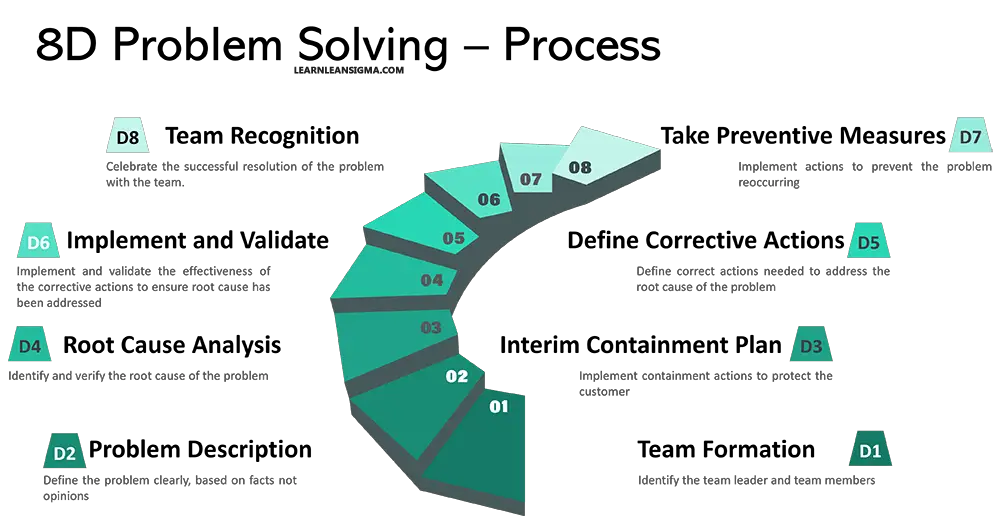
1. Skipping Steps
Background:.
The 8D problem-solving process is designed as a step-by-step approach to ensure that teams address problems comprehensively and systematically. Each step plays a crucial role in understanding, diagnosing, and resolving the issue at hand.
One common pitfall is the temptation to skip or rush through certain steps. This often occurs because teams believe they have a grasp of the problem based on preliminary observations or past experiences. Especially in the initial stages—where defining and describing the problem is crucial—this oversight can result in a superficial understanding, leading to ineffective or misaligned solutions.
By not giving each step its due diligence, teams risk:
- Misdiagnosing the real issue
- Implementing solutions that don’t address the root cause
- Wasting resources on ineffective strategies
How to Avoid:
To counteract this, it’s vital to treat each step with equal importance, resisting the urge to jump ahead. A thorough understanding of the problem, achieved by diligently following each step, lays the foundation for effective solutions. Regular checkpoints can also be established to ensure that each step has been comprehensively addressed before progressing.
Free Lean Six Sigma Templates
Improve your Lean Six Sigma projects with our free templates. They're designed to make implementation and management easier, helping you achieve better results.
2. Not Forming a Diverse Team
The essence of the 8D problem-solving approach is collaborative teamwork. The collective insights, experiences, and skills of a team often lead to more innovative and effective solutions than individual efforts.
A frequent oversight is forming teams where members have similar backgrounds, experiences, or perspectives. Such homogeneity can lead to a narrow viewpoint, where potential solutions or root causes might be overlooked.
A homogeneous team can result in:
- Limited creativity and innovation
- Overlooking potential solutions or root causes
- Confirmation bias, where members validate each other’s perspectives without critical evaluation

To ensure a holistic understanding of the problem and a diverse range of solution options, teams should be multidisciplinary. This means including members from various departments, roles, and, if necessary, external stakeholders. Such diversity brings a plethora of perspectives, fostering rich discussions, challenging established norms, and ensuring that the problem is viewed from all possible angles.
3. Failing to Document Everything
Documentation is the backbone of a structured problem-solving process like 8D. It provides a tangible trail of the team’s journey, from problem identification to solution implementation.
Teams often become so engrossed in discussions, brainstorming sessions, and solution implementation that they forget or deemphasize the importance of documentation. This oversight can stem from a belief that the issue at hand is straightforward or that team members will remember crucial details.
Neglecting documentation can lead to:
- Loss of vital information, especially if team members change or are unavailable.
- Inconsistencies in understanding or approach, as verbal discussions may be interpreted differently by different members.
- Difficulty in tracking progress or revisiting decisions when needed.
- Challenges in replicating the solution process for similar problems in the future.
To ensure thoroughness and continuity, teams should maintain detailed records at every stage. This includes documenting:
- Problem descriptions
- Data gathered
- Analysis results
- Discussions and brainstorming sessions
- Decisions made and their rationale
- Implemented solutions and their outcomes
Using collaborative tools or platforms can help streamline this process and provide a centralized repository accessible to all team members.
4. Not Validating Root Causes
Identifying the root cause of a problem is pivotal in the 8D approach. It ensures that solutions address the underlying issue, not just the symptoms.
In their eagerness to resolve the problem, teams sometimes latch onto the first plausible cause they identify. This premature conclusion can stem from confirmation bias, where individuals seek out information that confirms their existing beliefs.
Settling on an unvalidated cause can result in:
- Implementing solutions that don’t address the real issue.
- Recurrence of the problem, leading to increased costs and wasted resources.
- Frustration and reduced morale, as teams feel they are repeatedly addressing the same issues.
Teams should employ a rigorous validation process for identified root causes. This can involve:
- Asking “Why?” repeatedly (typically five times) to drill down into the underlying cause—a technique known as the “ 5 Whys .”
- Using structured analytical tools like Fishbone diagram s (also known as Ishikawa or Cause and Effect diagrams) to explore all potential causes in a systematic manner.
- Testing the hypothesized root cause in real-world scenarios to see if addressing it resolves the problem.
5. Implementing Quick Fixes
In the face of pressing problems, there’s often a natural inclination to find the quickest way to alleviate the immediate pain or visible symptoms. This can lead to teams opting for “band-aid” solutions or quick fixes.
Choosing the path of least resistance or the fastest remedy often means addressing only the surface-level symptoms of a problem, rather than its root cause. This approach can be driven by time constraints, pressure from stakeholders, or a desire for immediate relief.
Relying on quick fixes can lead to:
- Recurrence of the problem, as the underlying cause remains unaddressed.
- Wasting resources on repetitive, short-term solutions.
- Eroding trust and confidence, as stakeholders see the same issues resurface.
To sidestep the pitfalls of quick fixes:
- Prioritize solutions that address the root cause of the problem, even if they take longer to implement.
- Educate stakeholders on the importance of sustainable solutions, emphasizing the long-term benefits over short-term relief.
- Allocate adequate time and resources for comprehensive problem-solving, recognizing that a deeper fix now can prevent repeated issues in the future.
6. Failing to Monitor the Effectiveness of Corrective Actions
The journey of problem-solving doesn’t end with the implementation of a solution. Continuous monitoring is essential to ensure that corrective actions deliver the desired results.
Once a solution is in place, teams might move on to other tasks, assuming that the problem is resolved for good. This complacency can stem from a belief that the implemented solution is foolproof or from a lack of resources dedicated to monitoring.
Not monitoring the effectiveness of corrective actions can result in:
- Unnoticed failures or inefficiencies in the implemented solution.
- Missed opportunities for improvement or optimization.
- Stakeholder dissatisfaction if the problem resurfaces or new issues emerge.
To ensure that corrective actions remain effective:
- Set up regular review intervals to assess the performance of the implemented solution.
- Define clear metrics or KPIs to objectively measure the success of the corrective actions.
- Foster a culture of continuous improvement, where teams are encouraged to iterate and refine solutions based on real-world feedback.
- Ensure open channels of communication with stakeholders to gather feedback and address any emerging concerns promptly.
7. Not Preventing Recurrence
Solving a problem doesn’t only involve addressing its current manifestation but also entails preventing its reoccurrence. This proactive approach ensures long-term success and stability.
Teams might focus so intently on resolving the immediate issue that they neglect to consider its potential to resurface. This oversight can be due to time constraints, a lack of comprehensive analysis, or simply underestimating the problem’s complexity.
Failing to prevent recurrence can lead to:
- Repeatedly addressing the same issues, leading to wasted time and resources.
- Erosion of stakeholder confidence as the problem keeps reappearing.
- Additional costs and disruptions associated with recurrent problems.
To ensure problems don’t keep reoccurring:
- Conduct a thorough post-mortem analysis to understand the factors that contributed to the problem’s occurrence.
- Identify and address any systemic vulnerabilities or gaps that might allow the problem to resurface.
- Implement preventive measures, which could include training, system upgrades, or process changes.
- Regularly review and update these measures based on new insights or changing circumstances.
8. Forgetting to Recognize the Team’s Efforts
Behind every problem-solving endeavor is a team of dedicated individuals working collaboratively. Recognizing their efforts is not only a sign of gratitude but also an essential component of team dynamics and motivation.
In the rush to move on to the next task or project, teams might forget to pause and acknowledge the hard work that went into solving the problem. This oversight can be unintentional, but its impact on team morale can be significant.
Not recognizing the team’s efforts can result in:
- Diminished motivation and engagement among team members.
- A feeling of being undervalued or overlooked, which can hamper future collaboration.
- Reduced willingness to go the extra mile in future projects or tasks.
To ensure teams feel valued and motivated:
- Set aside time at the end of a project or task for reflection and acknowledgment.
- Celebrate successes, no matter how small, through team gatherings, awards, or simple words of appreciation.
- Foster a culture where team members regularly acknowledge and praise each other’s contributions.
- Encourage feedback and provide opportunities for team members to share their experiences and learnings.
In problem-solving, the 8D methodology stands out for its structured and comprehensive approach. However, even within such a robust framework, pitfalls await the unwary. From the temptation of quick fixes to the oversight of not preventing recurrence, these challenges can undermine the effectiveness of solutions. Moreover, the human element—recognizing and valuing the team’s contributions—is just as pivotal as the technical steps. To truly harness the power of 8D, it’s essential to be cognizant of these common mistakes and proactively work to sidestep them. By doing so, teams not only address current issues effectively but also lay the foundation for sustainable success and continuous improvement in their organizations.
- Zarghami, A. and Benbow, D.W., 2017. Introduction to 8D problem solving . Quality Press.
- Camarillo, A., Ríos, J. and Althoff, K.D., 2017. CBR and PLM applied to diagnosis and technical support during problem solving in the Continuous Improvement Process of manufacturing plants . Procedia Manufacturing , 13 , pp.987-994.
Was this helpful?

Daniel Croft
Daniel Croft is a seasoned continuous improvement manager with a Black Belt in Lean Six Sigma. With over 10 years of real-world application experience across diverse sectors, Daniel has a passion for optimizing processes and fostering a culture of efficiency. He's not just a practitioner but also an avid learner, constantly seeking to expand his knowledge. Outside of his professional life, Daniel has a keen Investing, statistics and knowledge-sharing, which led him to create the website www.learnleansigma.com, a platform dedicated to Lean Six Sigma and process improvement insights.
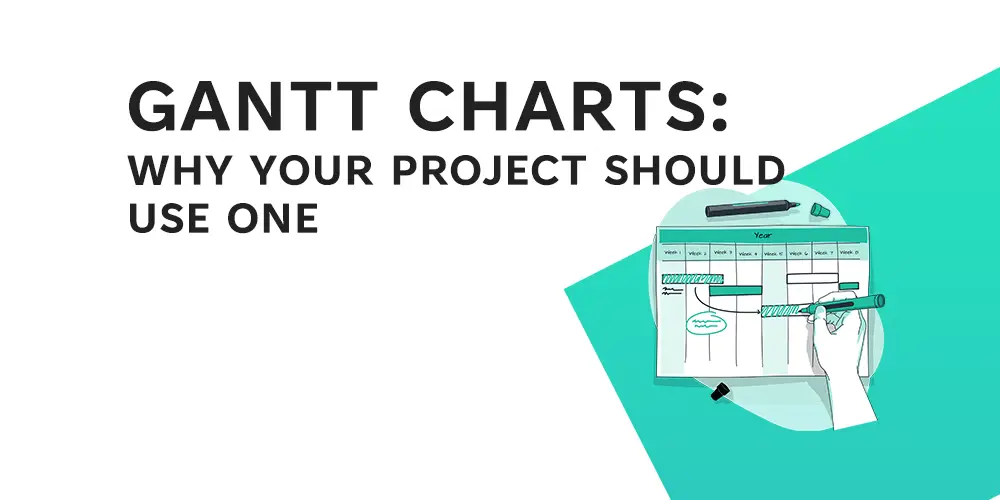
Why You Should Use a Gantt Chart for Your Project
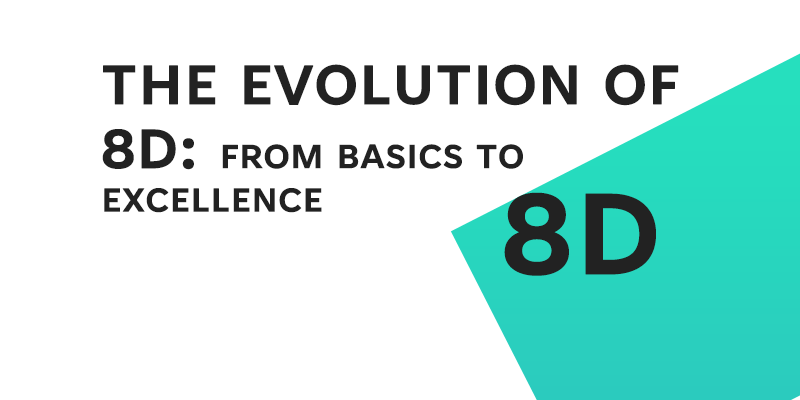
The Evolution of 8D Problem-Solving: From Basics to Excellence

LIFO or FIFO for Stock Management?
Choosing between LIFO and FIFO for stock management depends on factors like product nature, market…
Are There Any Official Standards for Six Sigma?
Are there any official standards for Six Sigma? While Six Sigma is a well-defined methodology…
5S Floor Marking Best Practices
In lean manufacturing, the 5S System is a foundational tool, involving the steps: Sort, Set…
How to Measure the ROI of Continuous Improvement Initiatives
When it comes to business, knowing the value you’re getting for your money is crucial,…
In today’s competitive business landscape, effective problem-solving is the cornerstone of organizational success. The 8D…
In a world where efficiency and effectiveness are more than just buzzwords, the need for…

IMAGES
VIDEO
COMMENTS
The eight disciplines (8D) model is a problem solving approach typically employed by quality engineers or other professionals, and is most commonly used by the automotive industry but has also been successfully applied in healthcare, retail, finance, government, and manufacturing. The purpose of the 8D methodology is to identify, correct, and ...
Eight Disciplines Methodology (8D) is a method or model developed at Ford Motor Company used to approach and to resolve problems, typically employed by quality engineers or other professionals. Focused on product and process improvement, its purpose is to identify, correct, and eliminate recurring problems. It establishes a permanent corrective action based on statistical analysis of the ...
8D Problem Solving is a systematic and structured approach used to solve business related problems. It names has been given by the fact there are 8 steps or 8 disciplines that are followed to identify, correct and eliminate recurring problems. 8D Problem Solving is regarded as robust methodology that has proven its worth across multiple ...
The 8D problem solving process is a detailed, team oriented approach to solving critical problems in the production process. The goals of this method are to find the root cause of a problem, develop containment actions to protect customers and take corrective action to prevent similar problems in the future. The strength of the 8D process lies ...
The Ford Motor Company® developed the 8D (8 Disciplines) Problem Solving Process, and published it in their 1987 manual, "Team Oriented Problem Solving (TOPS)." In the mid-90s, Ford added an additional discipline, D0: Plan. The process is now Ford's global standard, and is called Global 8D. Ford created the 8D Process to help teams deal with ...
The eight disciplines (8D) method is a problem-solving approach that identifies, corrects, and eliminates recurring problems. By determining the root causes of a problem, managers can use this method to establish a permanent corrective action and prevent recurring issues. First introduced by Ford, the 8D method offers a consistent way of ...
The 8D Problem Solving (also known as Eight Disciplines) is used to solve a complex problem using eight steps. It is a team-oriented method. The 8D approach is based on solving the problem through short-term (temporary) saluting to reduce or stop the negative impact of the situation while the team is looking for the problem's root cause to ...
8D (or Eight Disciplines of Problem Solving) is a methodology for solving problems that aims to identify the root cause of the problem and provide a solution. 8D is a great first step in improving quality and reliability. Ford Motor Company created this problem-solving method, which was then called Team Oriented Problem Solving.
Abstract. The 8D problem solving method is a scientific, systematic approach which has similarities to the DMAIC method. The overlap in the two methods is briefly discussed in this overview of the 8D approach. 8D is usually driven by the customer; as the process is meant to resolve a specific customer complaint.
How to use 8D for problem solving. The 8D method above outlines a proven strategy for identifying and dealing with problems. It's an effective problem solving and problem prevention process. In addition to avoiding long-term damage from recurring problems, 8D also helps to mitigate customer impact as much as possible.
Open communication within the team and with management. A framework for corrective action that allows for systemic changes and continual improvement. Intense examination of the control systems that permitted the problem. Easy integration with process-improvement tools. You can apply the 8Ds whenever processes break down.
8D Problem Solving is a structured, team-oriented methodology that consists of eight steps—known as the Eight Disciplines—to identify, analyze, and resolve complex problems. Originally formalized by Ford Motor Company, this approach is widely used across various industries for its effectiveness in finding and eliminating the root causes of ...
By embracing quality management principles like ISO 9001, the 8D approach transformed from a 'military-specific' solution to a universally applicable method for problem-solving. This was a pivotal moment in its history, paving the way for the methodology's future evolutions and its adoption across diverse sectors.
The 8D approach to problem-solving, also known as the 8D methodology, is a systematic and comprehensive method used to address and resolve complex issues, particularly in manufacturing and other industries. This 8D troubleshooting methodology involves a structured process designed to identify, correct, and prevent issues, ensuring that similar ...
What is 8D problem-solving? 8D problem-solving is an approach that quality engineers and manufacturers use to identify and address challenges throughout a project. 8D refers to the eight different disciplines, or steps, that the process entails. Note that since its inception, the 8D problem-solving method has added a stage for planning at the ...
The 8D Problem Solving method is an effective and adaptable way for tackling complicated challenges in a variety of industries. Organizations may methodically identify and address problems, stop them from happening again, and promote a culture of continuous improvement and adhering to the eight disciplines.
What Exactly is an 8D Problem-Solving Method? 8D is commonly referred to as "8 Disciplines" or "8 Critical Steps" for solving quality problems. It is a team-oriented method of managing quality issues, which is highly disciplined and effective. Based on the teamwork, this method offers stepwise guidelines to identify the root cause ...
What 8D method is. 8D, stands for eight disciplines, is a well-recognized and often used problem-solving approach. It's mostly used by quality engineers and/or other professionals to get to the root cause of a recurring issue, eliminate the number of the problems, and hopefully solve it once and for all.
Developed by the Ford Motor Company during the 1960s and 1970s, 8D Problem Solving, is a tool that aims to effectively identify and address recurring problems.(also known as the "8 Disciplines for Problem Solving").. It consists of a tool with 8 steps or disciplines to be followed to treat a problem so that it does not occur again.. The tool's focus is to identify the root cause of the ...
The 8D method is widely used for problem-solving, especially in the automotive industry. However, like any approach, it has its advantages and disadvantages compared to other popular methods like DMAIC, A3, or PDCA. Here's an overview of the pros and cons of the 8D method compared to these methods.
Conclusion. In Conclusion, 8D Problem Solving is a structured and effective method for dealing with complex issues in any industry. This process brings together a cross-functional team to analyse and solve problems systematically, resulting in long-term solutions and continuous improvement.
The 8D (8D Problem-Solving Method) method, also known as 8 disciplines, first appeared in Ford's 1987 "Team-Oriented Problem Solving" manual.It is a tool that has stood the test of time and has become the first solution used by the company known today as Global 8D. Although the 8D method has been around for years, many companies still face the problem of low resolution and poor use of fixes.
The 8D method is a popular way teams solve problems step-by-step. It's like a roadmap that helps teams figure out what went wrong and how to fix it for good. ... In problem-solving, the 8D methodology stands out for its structured and comprehensive approach. However, even within such a robust framework, pitfalls await the unwary. From the ...